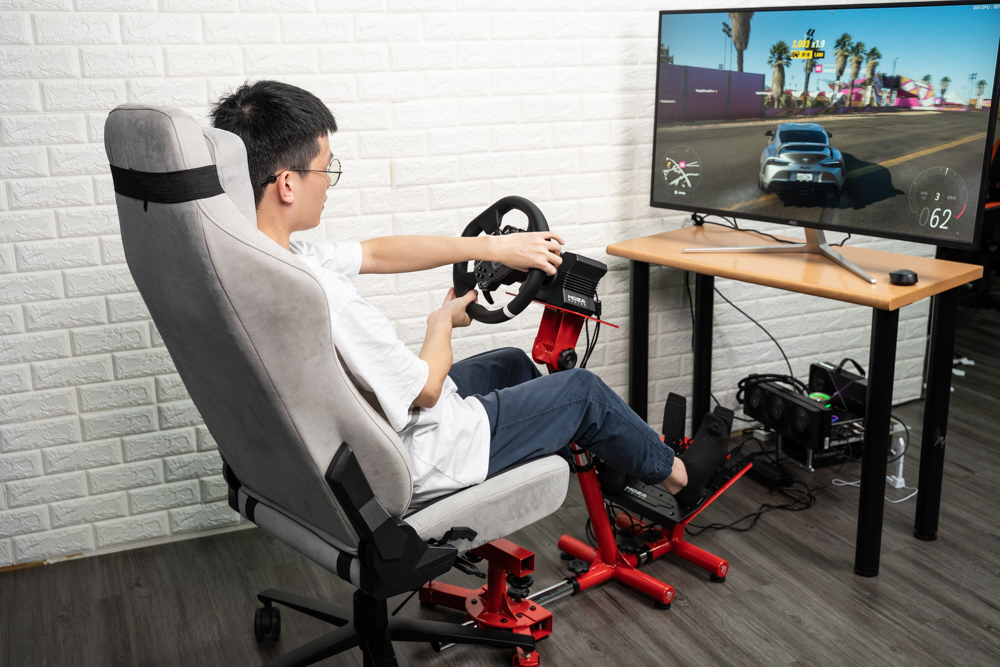
The MOZA Racing brand is revolutionizing the racing simulator world with its groundbreaking approach to pricing. They’ve brought the advanced servo direct drive technology, once exclusive to high-end simulators, down to the price range of traditional belt and gear steering wheels. This innovation, paired with diligent software updates supporting dozens of mainstream racing games, allows enthusiasts to enjoy a driving experience closer to reality at an entry-level price. The fun and feedback of real driving become more accessible, enhancing the thrill of racing games without breaking the bank.
Coupled with the affordable Arozzi Velocita omnidirectional simulator racing frame, the setup offers a minimal footprint while providing a wide range of adjustments for a more comfortable driving posture. It’s designed to deliver a rich simulator experience in the smallest space possible, transitioning from what might feel like playing with a toy to engaging in a more serious racing simulation.
Specifications for the MOZA R5 Base include:
- Drive Type: Direct drive
- Maximum Torque: 5.5 Newton meters
- Body Material: Aluminum alloy
- Motor Resolution: 15bit
- Intelligent Temperature Control: Supported
Specifications for the MOZA ES Steering Wheel include:
- Diameter: 11 inches
- Grip Material: Leather
- Wheel Body Material: Aluminum alloy
- Paddle Material: Aluminum alloy
- Number of Buttons: 22
- Quick Release Steering Wheel: Supported
Specifications for the MOZA SR-P Lite Pedals include:
- Material: High-strength steel
- Sensing Type: Hall sensor
Specifications for the Arozzi Velocita Omnidirectional Simulator Racing Frame include:
- Material: Metal
- Adjustable Gear Shift Bracket: Height / Rotation / Lateral / Longitudinal adjustments
- Adjustable Steering Wheel Bracket: Height / Longitudinal angle adjustments
- Adjustable Throttle Pedal: Tilt / Longitudinal adjustments
- Net Weight: 19KG
This combination of MOZA Racing’s direct drive technology and Arozzi’s versatile racing frame brings a new level of immersion and realism to racing simulations, making it an enticing option for newcomers and seasoned sim racers looking for an upgrade without the hefty price tag. The focus on providing a realistic driving experience, robust build quality, and comprehensive game support sets a new standard in the entry-level racing simulator market.
MOZA Racing R5 Review: Elevating Your Racing Simulator Experience with Cutting-Edge Technology and Affordable Quality
The MOZA RACING R5 racing simulator kit is a standout in the racing simulator market, featuring MOZA RACING’s cutting-edge direct drive technology. This set, which has made its way into Taiwan, includes the R5 servo direct drive base with a desk clamp, the ES steering wheel, and the SR-P Lite pedals. It’s an essential starter pack for novices, but MOZA RACING’s offerings don’t end there. Their product line extends beyond just bases to include a variety of steering wheels, pedals, and gear shifters that cater to different gaming preferences and personal habits.
At the heart of any racing simulator is the base, which houses the motor driving the steering wheel. In simulators, where the real-world g-forces of a car cannot be replicated, all the driver feedback has to come through the wheel, making the quality of this feedback critical. The main types of bases are belt gear-driven and direct drive. The former tends to have wear and tear with less strong and less refined force feedback, while the direct drive system—where the motor directly drives the steering wheel—offers robust, low-latency feedback, providing a much more nuanced and realistic experience. In comparison, belt gear-driven wheels are more like toys, whereas direct drive systems are true simulators.
The MOZA R5 base is the most budget-friendly direct drive option in the MOZA lineup, offering a maximum torque of 5.5 Newton-meters. Above the R5 are the R9, R12, R16, and R21 models, which provide even greater torque. But is 5.5 Newton-meters enough? It’s considerably stronger than any belt gear-driven base, and from an editor’s perspective, when the force feedback is set to 100%, it’s almost challenging to control the steering wheel completely, making it more than sufficient for beginners. It’s not recommended to jump straight to a higher torque base; the advantage of higher torque is more delicate feedback and a broader dynamic range.
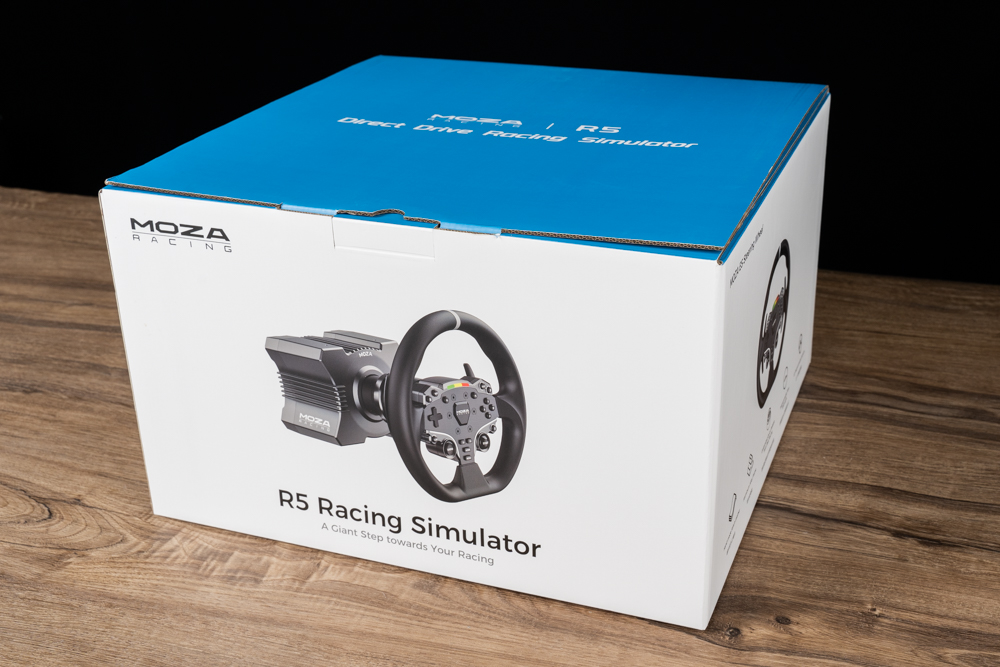
The MOZA RACING R5 Racing Simulator’s packaging, illustrates the commitment to quality even before you unbox the product. The design conveys a premium feel, aligning with the brand’s reputation for providing high-quality sim racing experiences at competitive prices. The package’s phrase “A Giant Step towards Your Racing” encapsulates the brand’s mission to bring professional-level sim racing to a wider audience.
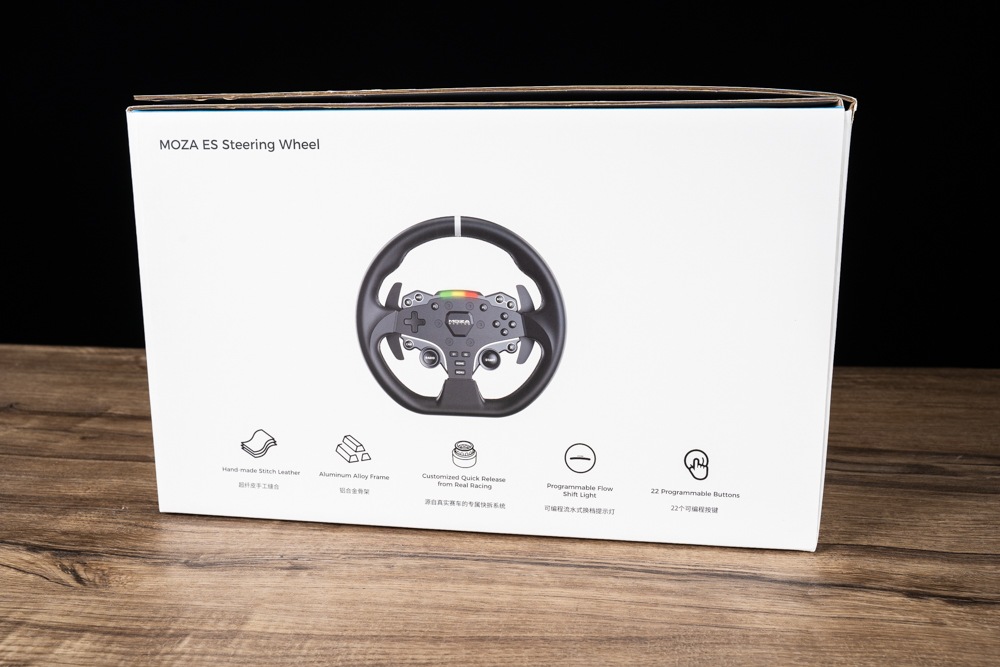
The packaging for the MOZA ES Steering Wheel is an integral component of MOZA RACING’s simulator ecosystem. It highlights features such as hand-made stitch leather, an aluminum alloy frame, a customized quick release adopted from real racing, a programmable flow shift light, and 22 programmable buttons. This combination of features suggests a product that is not only built with high-quality materials but is also customizable and adaptable to the user’s preferences, offering a personalized and immersive sim racing experience. The clean and professional packaging design emphasizes the product’s premium qualities and advanced technology, promising precision and control for an authentic racing simulation.
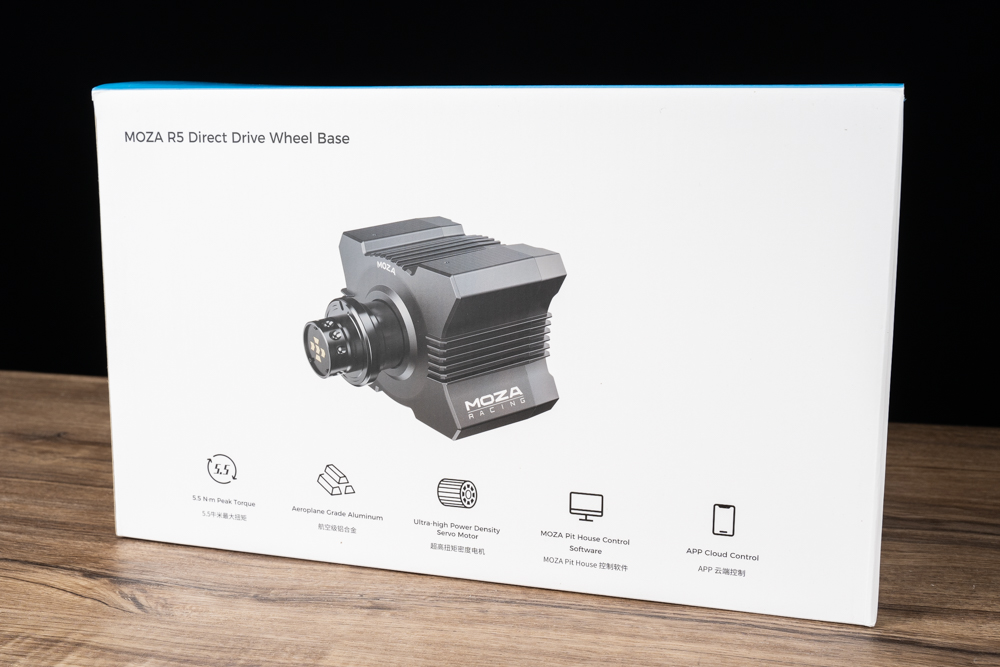
The MOZA R5 Direct Drive Wheel Base packaging, highlights its key features which include a 5.5 Nm peak torque, aeronautics-grade aluminum construction, ultra-high power density servo motor technology, MOZA Pit House Control Software, and APP Cloud Control functionality. The product packaging reflects a sleek and modern design, emphasizing the base’s capabilities and the advanced technology that enhances the racing simulator experience for users. With the promise of high torque and precision, the R5 Wheel Base is positioned as a reliable and powerful foundation for a high-fidelity racing simulation setup.
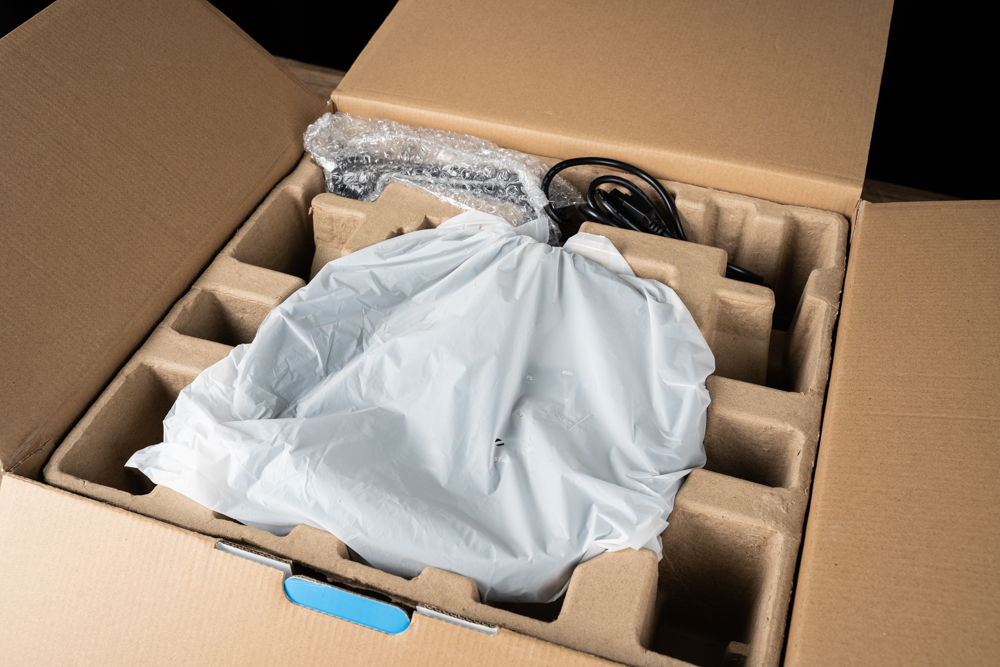
The interior of a product’s packaging, where we can see an item wrapped in protective plastic, secured within a cardboard box with paper-based cushioning. It appears the packaging is designed for safe transport, ensuring the item within is well-protected against impacts during shipping. This kind of eco-friendly, recyclable paper packaging is an excellent choice for companies looking to reduce their environmental footprint while still providing ample protection for their products.
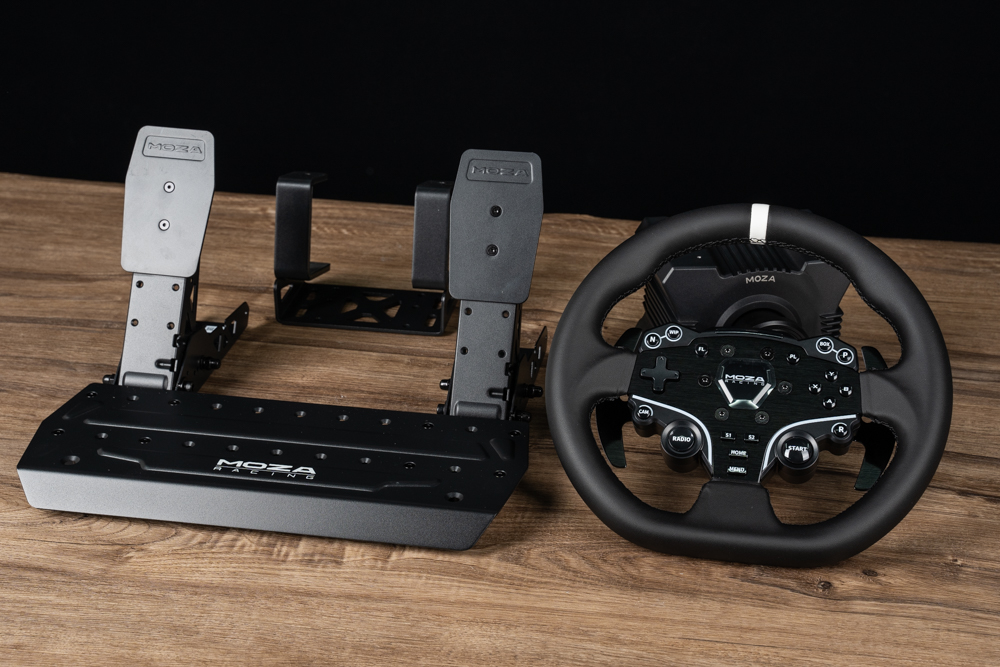
The main components of the MOZA R5 racing simulator setup, include the R5 servo direct drive base, a table clamp for the steering wheel, the ES steering wheel, and the SR-P Lite dual pedal set. This setup represents a comprehensive package for racing simulator enthusiasts, combining high-quality construction and technological sophistication to deliver a realistic driving experience. The design of the equipment is sleek and modern, emphasizing functionality and durability for an immersive simulation.
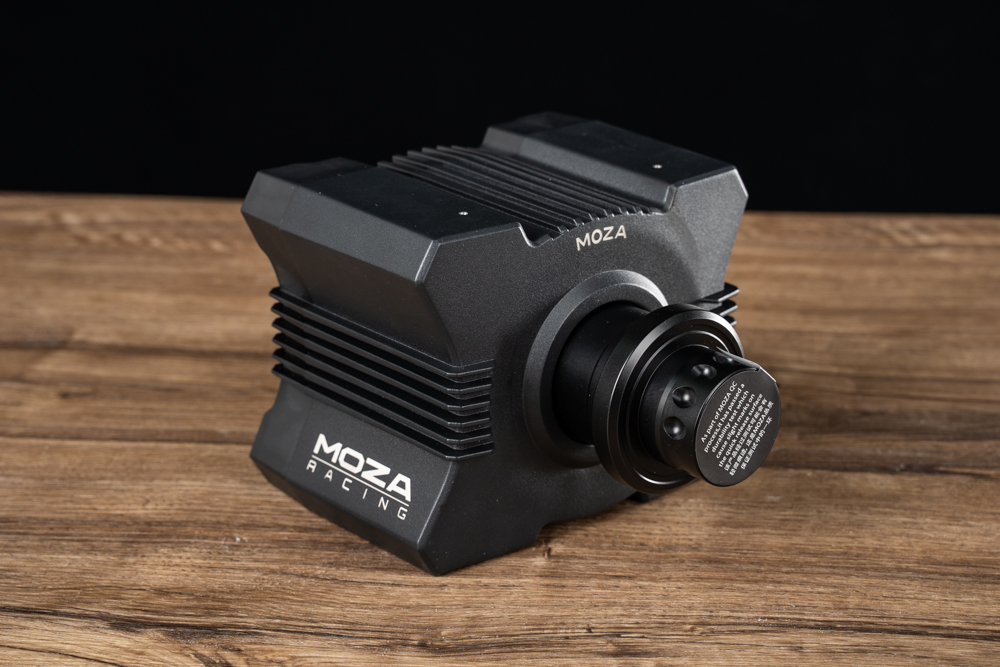
The MOZA R5 base, a component of MOZA RACING’s simulator setup. The base appears robust with its sturdy construction and ribbed design, which suggests enhanced durability and possibly better heat dissipation. It features a quick-release mechanism, indicating ease of use and the ability to switch out compatible steering wheels quickly. The branding is prominently displayed, reinforcing the identity of the product as part of the MOZA RACING ecosystem. This base is a crucial part of the simulator, offering the direct drive system that provides precise and realistic feedback to the driver.
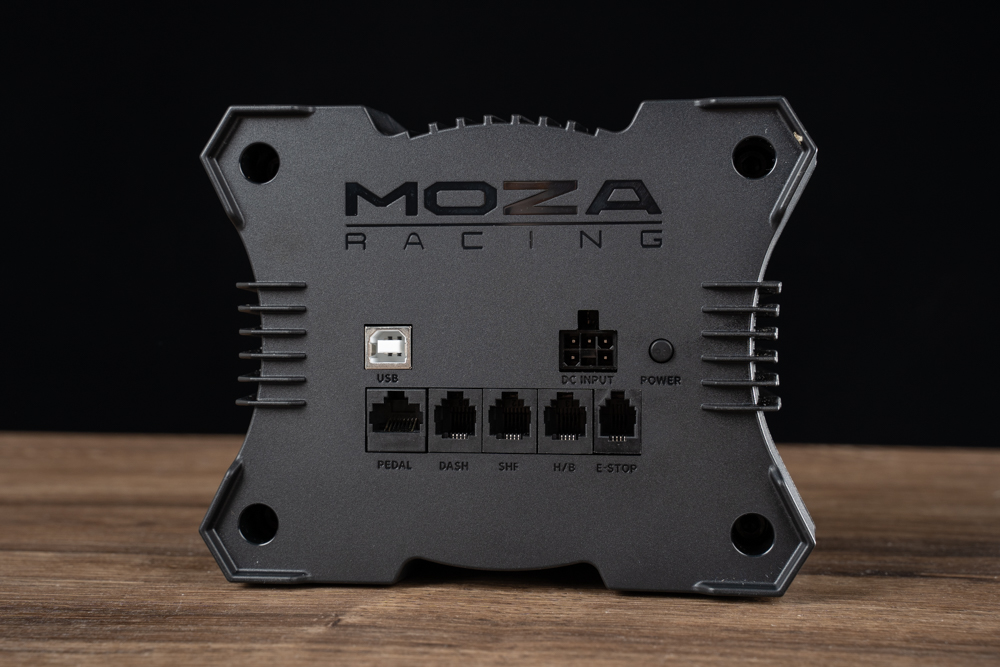
A clear view of the I/O (Input/Output) interface of the MOZA RACING simulator’s hardware. It includes a variety of ports, such as USB for connecting to a computer, dedicated ports for pedals (PEDAL) and dashboard (DASH), shifters (SHF), handbrake (H/B), and an emergency stop (E-STOP). There’s also a DC input for power, alongside a switch for powering the device on and off. This array of connections supports a range of peripheral devices, allowing users to customize their racing simulator setup with various inputs for a more realistic and engaging driving experience. The design is utilitarian, focused on functionality and ease of access for the user, and is consistent with MOZA RACING’s sleek, professional aesthetic.
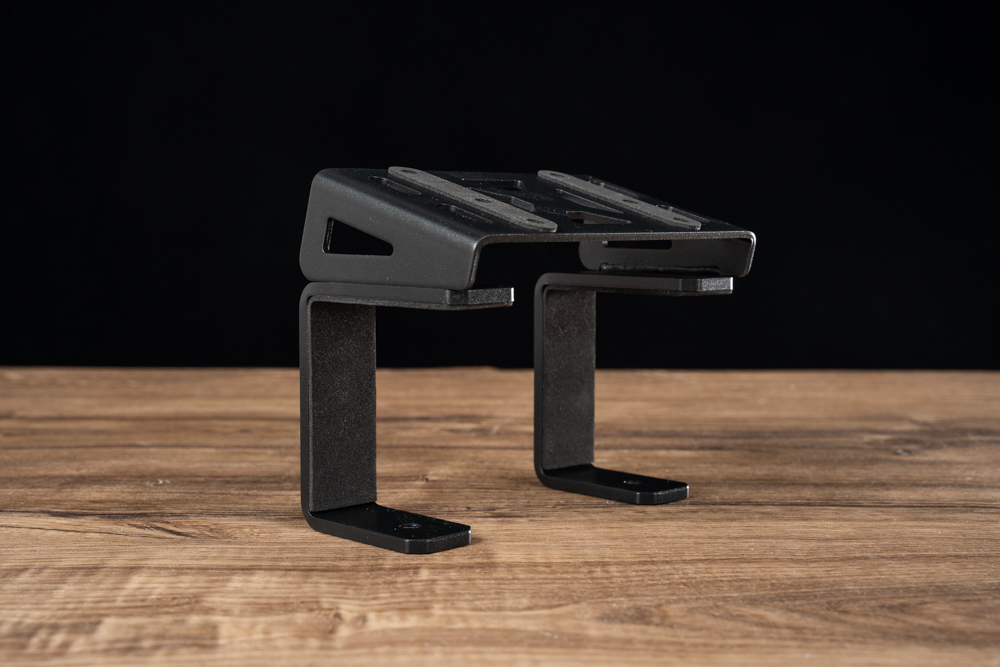
The table clamp is designed for securing a racing wheel base to a desk or table. It’s part of the MOZA R5 racing simulator setup, designed to provide stability for the direct drive wheel base during intense racing sessions. The clamp looks robust, with a solid construction and a broad contact surface to ensure a secure mount. The design appears to be user-friendly for easy installation and adjustment, allowing sim racers to set up their equipment quickly and efficiently. This clamp exemplifies the attention to detail and the focus on quality and user experience that is typical of the MOZA RACING brand.
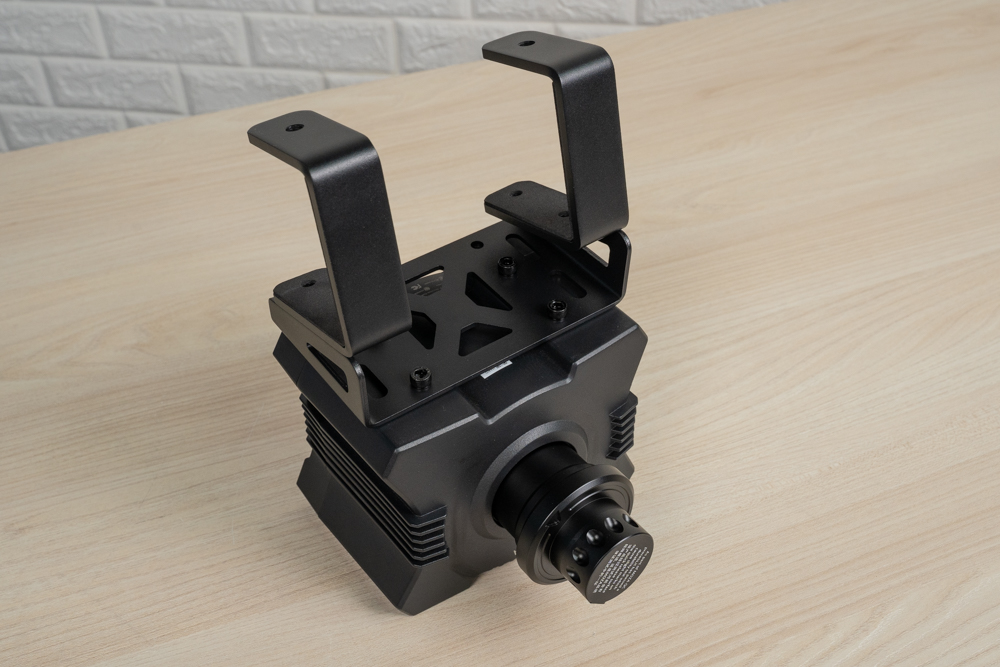
The table clamp attached to the MOZA R5 racing wheel base secured firmly with four screws. The setup suggests a stable and sturdy mount for the wheel base, ensuring it remains in place even during vigorous steering maneuvers. This mounting system is crucial for maintaining the realism and immersion that sim racers seek, as it minimizes movement and allows for a more precise and direct input response from the wheel. The design of the base and clamp system showcases practicality and efficiency, with an emphasis on a secure and straightforward user assembly process.
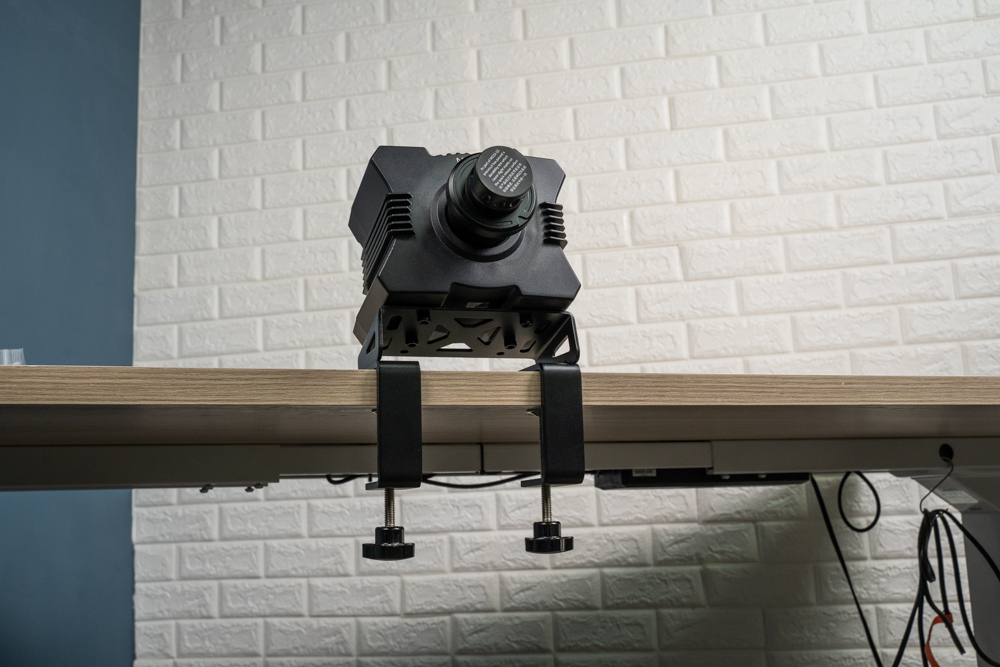
The MOZA R5 wheelbase is securely fastened to a tabletop using the dedicated table clamp. The setup appears solid and stable, with the clamp providing a firm grip on the table’s edge. It’s designed to keep the wheel base fixed, ensuring consistent performance and reliability when used during sim racing. While this particular setup doesn’t seem to offer angle adjustability, its robust design ensures that the base stays stationary, which is crucial for maintaining the precision and accuracy needed for an immersive racing simulation experience.
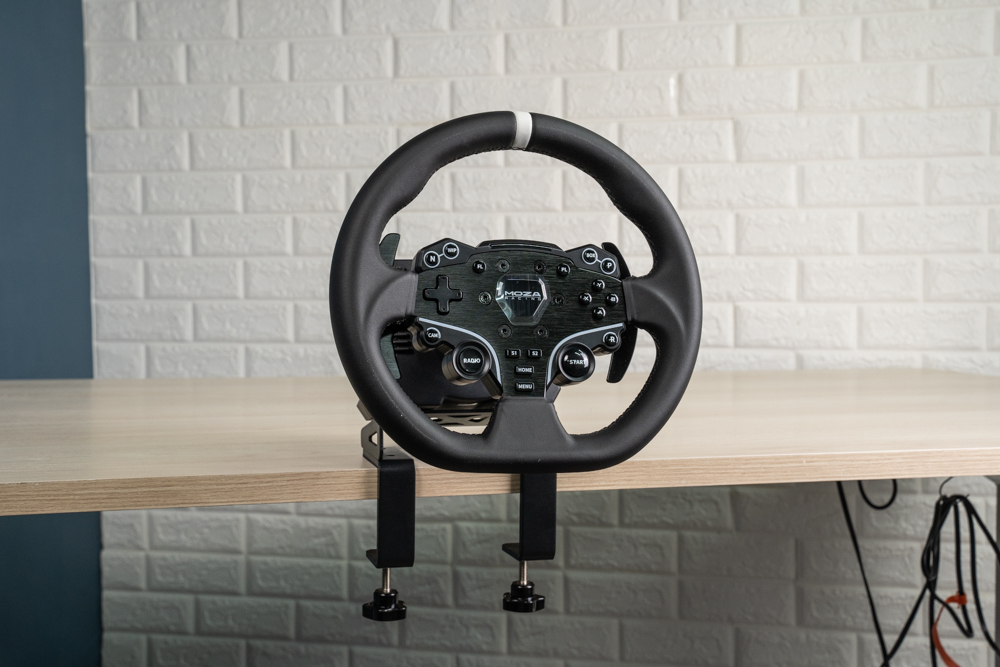
The MOZA ES steering wheel is installed on the R5 wheelbase, and clamped securely to a table. This configuration provides a clear view of how the steering wheel complements the wheelbase, forming a cohesive unit ready for an engaging sim racing experience. The setup is designed for straightforward integration, with the driver’s steering wheel positioned for easy access and comfortable use. It emphasizes the simplicity and user-friendliness of the MOZA RACING system, which is tailored for enthusiasts seeking a realistic racing simulation in their home setup.
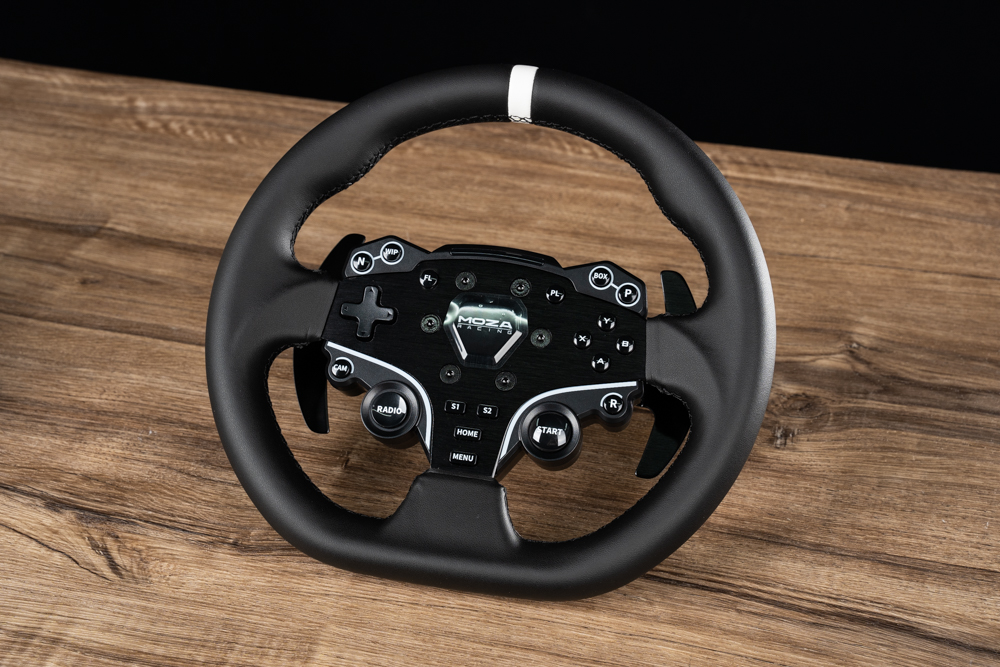
The MOZA ES steering wheel, part of the R5 racing simulator kit, is indeed a remarkable piece of equipment. Its 11-inch diameter is slightly smaller than most standard car wheels, aligning closer to the dimensions preferred in racing vehicles, which often facilitates quicker and more precise steering inputs.
This wheel impressively packs high-end features into an entry-level model. The 22 programmable buttons, paddle shifters, and RPM indicator lights are usually found on more expensive models. The leather wrapping adds a touch of luxury and comfort, improving grip and the overall driving experience. Its quick-release design not only adds convenience when setting up or switching between different games but also enhances the realism, echoing the functionality of actual race cars.
The versatility of swapping out the wheel rim to match various game styles—from Formula 1 to truck simulators—shows MOZA’s commitment to providing a comprehensive, adaptable sim racing ecosystem that caters to a wide range of preferences and stimulating experiences. This capability allows users to tailor their setup to their racing style or the specific demands of different racing disciplines, enhancing the immersion and overall enjoyment of their sim racing experience.
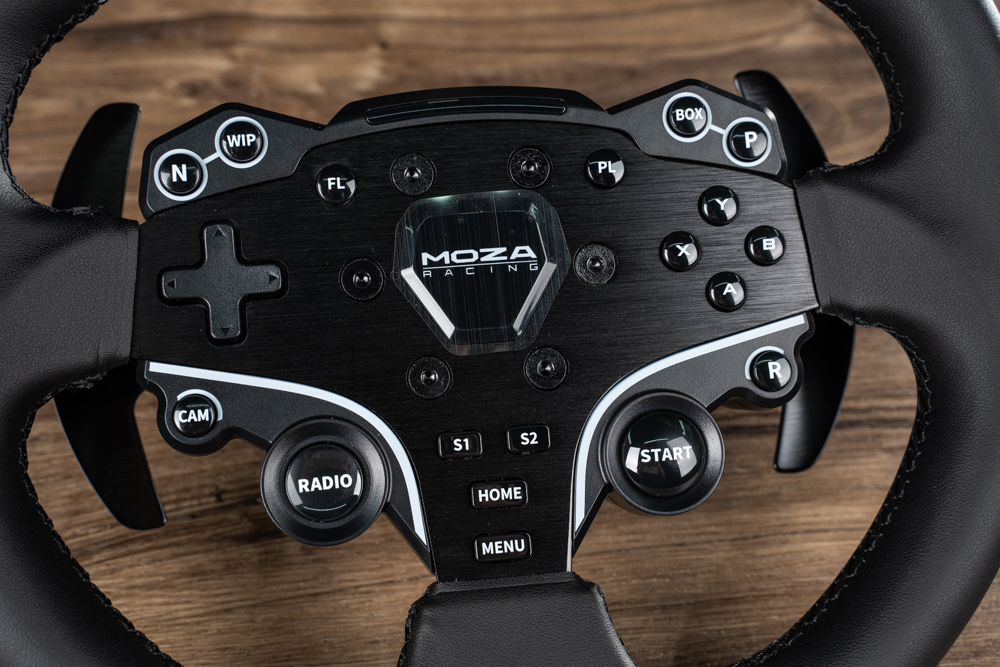
The MOZA ES steering wheel showcases the intricate design and user-centric layout of the 22 programmable buttons. Each button is strategically placed for intuitive access, allowing drivers to customize their controls for an optimized racing experience. The wheel’s button configuration, which includes labels such as “WIP,” “N,” “FL,” “CAM,” “RADIO,” and others, resembles the complex functionality found in real race car steering wheels, enabling sim racers to perform a variety of in-game actions without taking their hands off the wheel. The mix of dials, toggle switches, and standard buttons adds a level of sophistication and adaptability, ensuring that every racer can tailor their setup to their personal or game-specific requirements. The presence of a start button also indicates a focus on simulating the actual process of igniting a race car, further enhancing the realism of the simulation.
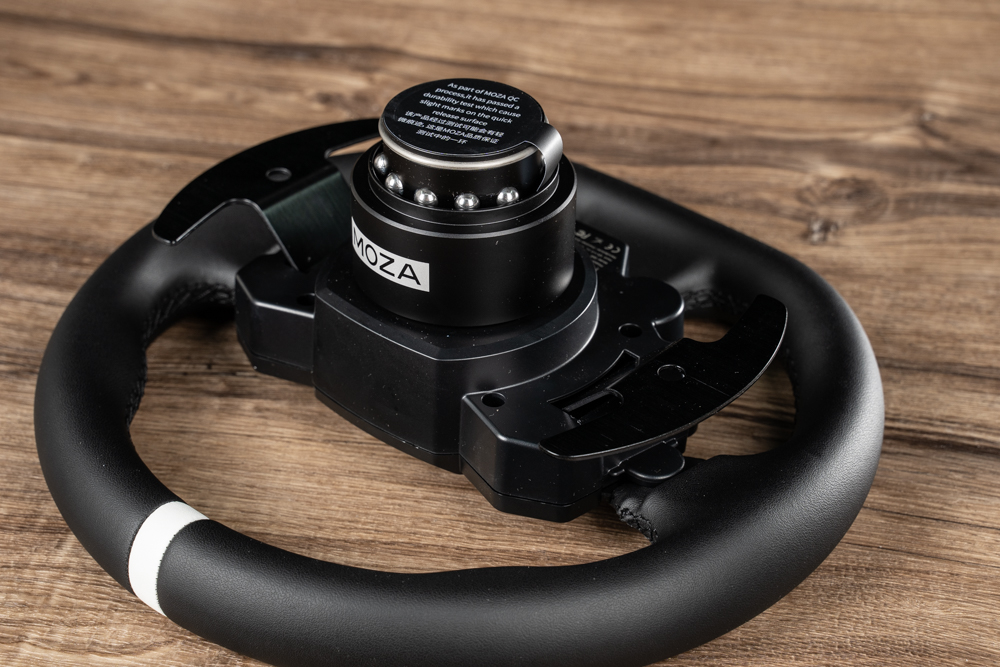
The backside of the MOZA ES steering wheel draws attention to the metal paddle shifters. Sim racers often prefer these paddles for their tactile feedback and durability, mirroring the feel of shifting gears in a real race car. The use of metal for constructing these paddles not only adds to the aesthetic quality of the wheel but also ensures longevity and precise actuation. This attention to detail in components like the paddle shifters indicates MOZA’s dedication to providing a high-fidelity simulation experience.
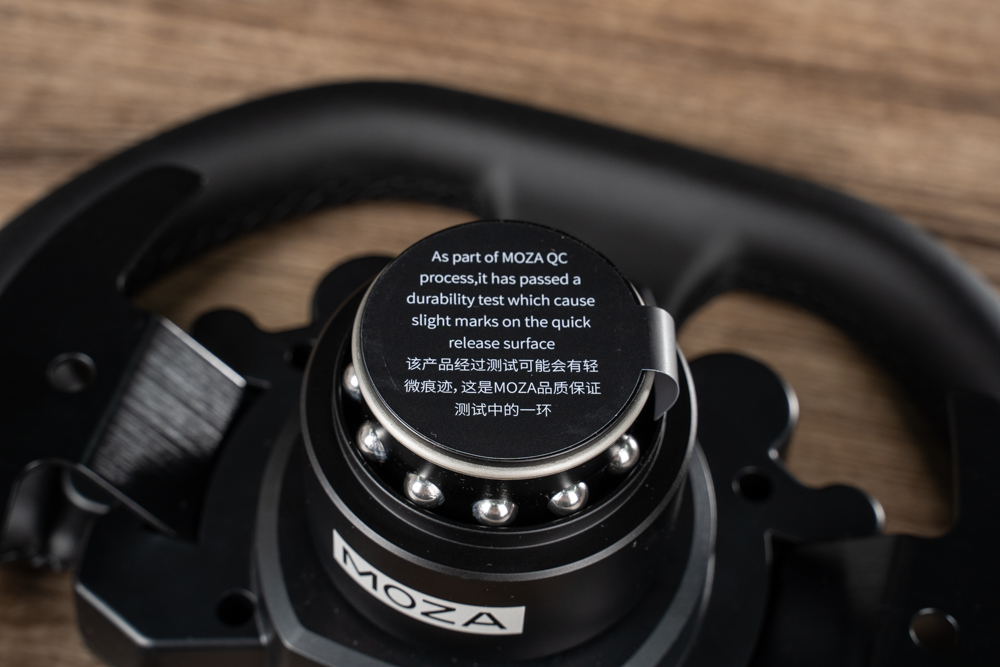
The quick-release system on the MOZA ES steering wheel. A label explains that as part of the MOZA quality control process, the quick-release has passed a durability test which may cause slight marks on the quick-release surface. This detail indicates MOZA’s commitment to quality assurance, ensuring that the quick-release mechanism is reliable and robust, even if it results in minor cosmetic blemishes. The quick-release feature is a convenient aspect for users who may want to switch between different styles of steering wheels for varying racing experiences. It’s designed for ease of use and quick changes, enhancing the overall functionality of the racing setup.
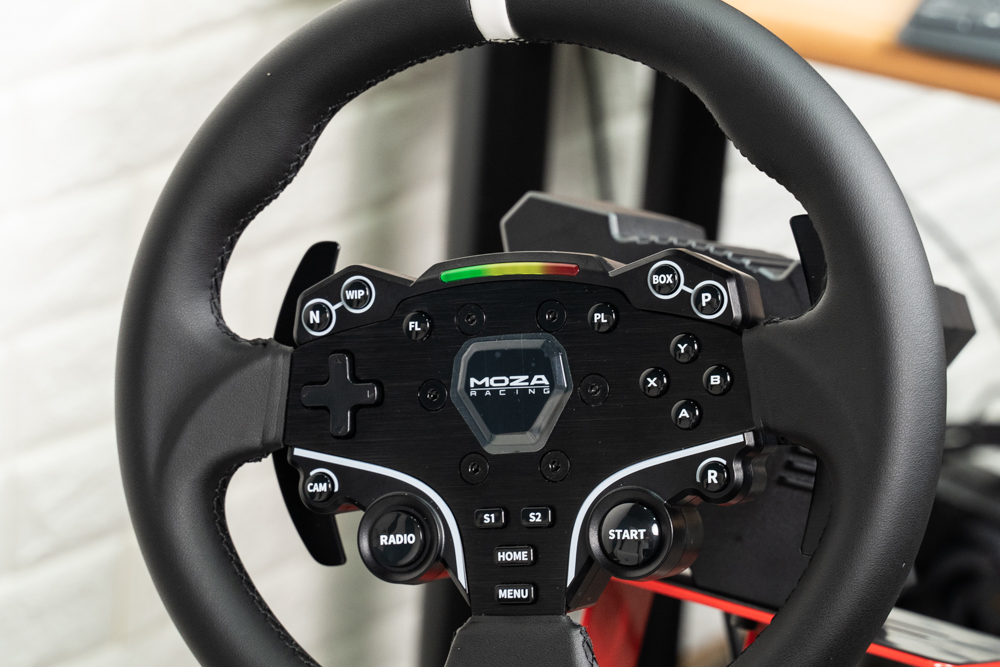
The MOZA ES steering wheel is is equipped with an RPM indicator light bar, commonly called a rev or shift light. It’s situated at the top of the wheel’s center hub, providing a clear visual cue to the driver. This feature helps racers optimize gear shifts by indicating the engine’s RPMs through a spectrum of colors that usually shift from green to red as the revs increase. Such an addition is particularly useful in sim racing, where physical engine feedback isn’t present, making it easier for drivers to know the ideal shifting points without looking away from the screen. It’s one of the many ways that MOZA has incorporated real racing elements into their sim racing gear to enhance the user’s experience.
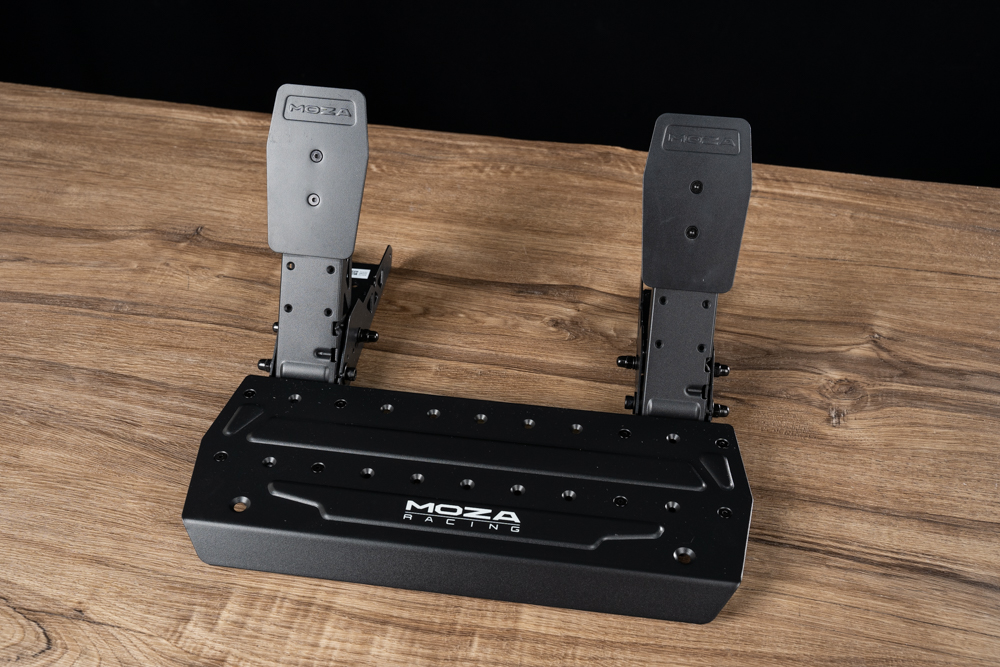
The MOZA SR-P Lite dual pedal set, a component of MOZA RACING’s sim racing equipment, is featured in the image. This pedal set is crafted from high-strength steel, ensuring durability and stability under intense use. The solid construction is designed to handle the forceful actions of sim racing, providing a stable foundation for precise throttle and brake application.
The pedals’ spacing is adjustable, offering customization to fit the ergonomics and preferences of individual drivers. This feature is significant for racers looking to emulate a realistic driving position or to simply find the most comfortable setup for long racing sessions.
For sim racers who desire a more comprehensive setup, there is the option to purchase a third pedal to simulate a clutch, further enhancing the realism of the driving experience. The pedals are also modifiable, with the capability to change springs or add other accessories. The high level of customizability underscores MOZA’s commitment to versatility within its product range, allowing users to tailor their sim racing gear to their exact preferences and needs. The ability for DIY modifications opens up many possibilities for personalization and upgrades, making the MOZA SR-P Lite dual pedal set a flexible choice for sim racing enthusiasts.
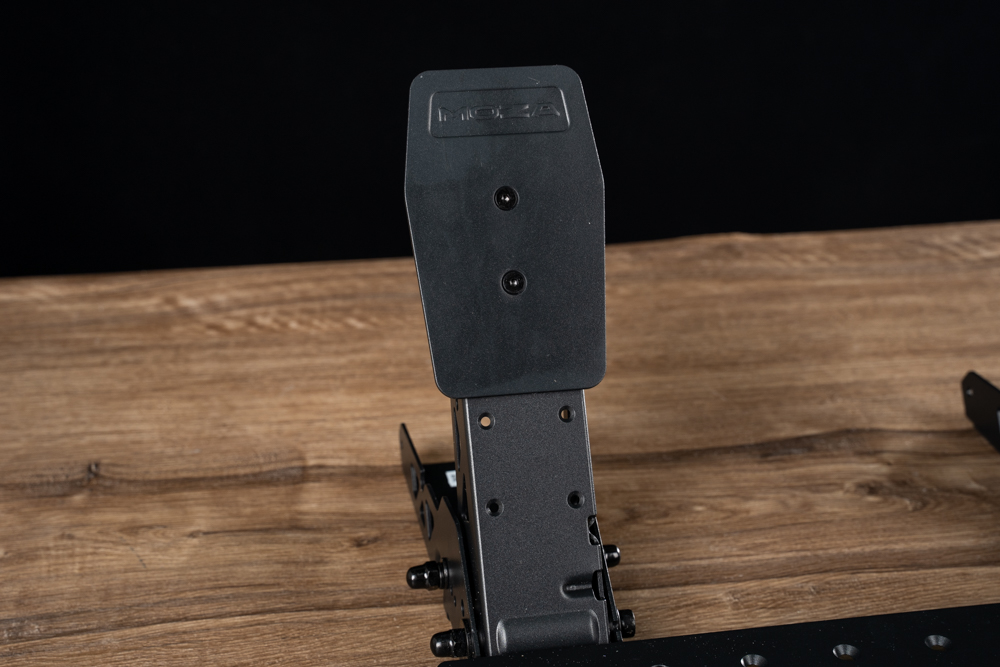
We see a close-up of one of the pedals from the MOZA SR-P Lite dual pedal set. The pedal is all-metal, emphasizing its robustness and quality construction. This design is likely to provide a satisfying, tactile response and resist wear over time, adding to the realistic feel and longevity of the sim racing experience. The sturdiness of the pedal also suggests that it can handle the vigorous demands of competitive racing simulations, where precision and durability are paramount. The attention to detail and the focus on materials that MOZA RACING has invested in their products underscore their commitment to delivering high-quality and authentic sim racing gear.
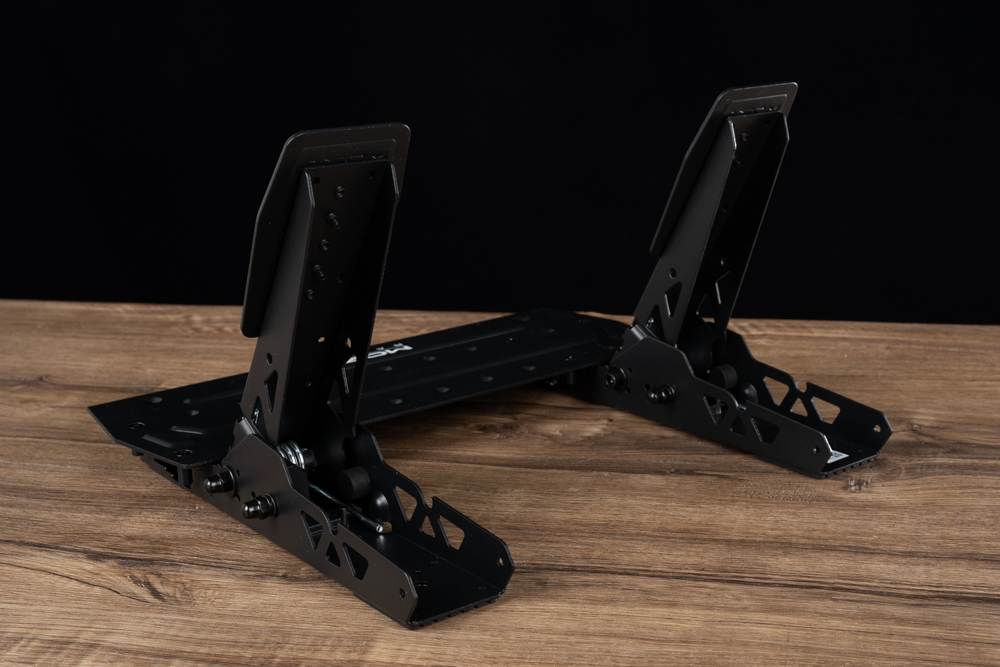
The underside of the MOZA SR-P Lite pedal set. The design features hall sensors, a non-contact sensor commonly used in high-end sim racing pedals. Hall sensors are favored for their accuracy and durability since they do not rely on physical contact that can wear down over time. They detect the pedal’s position with magnetic fields, providing a smooth and consistent input signal. This technology enhances the pedal’s ability to deliver precise throttle and brake control, contributing to a more realistic and immersive driving experience for the user. The intricate cutouts and robust mounting points in the design also speak to the thoughtful engineering aimed at performance and aesthetic appeal.
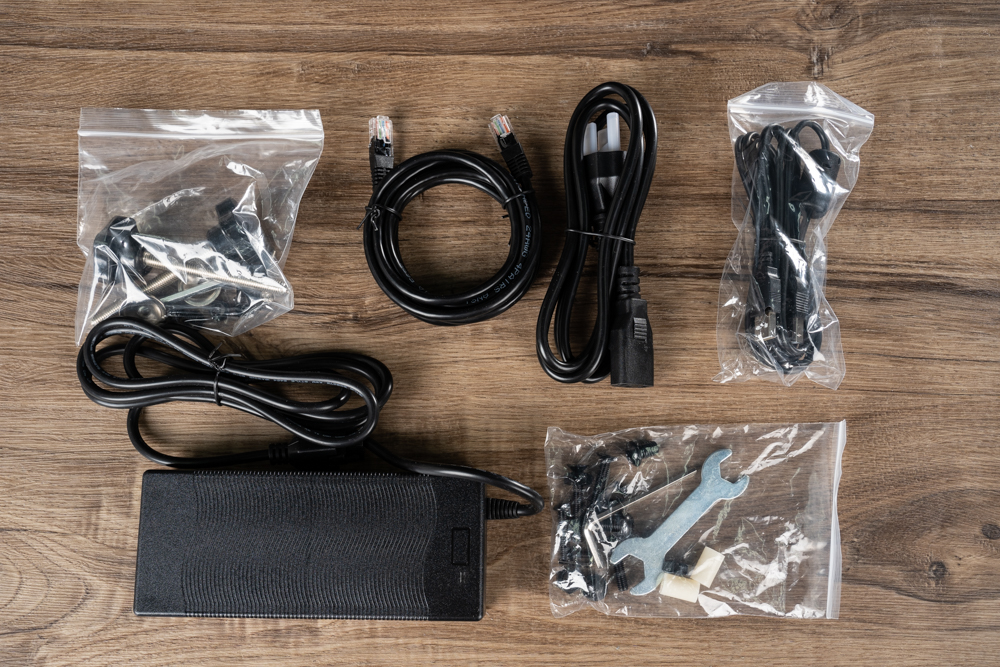
A view of the various accessories included with the MOZA racing simulator equipment. This assortment typically contains all the necessary cables for power and connectivity, such as power adapters and USB cables, ensuring that users can easily connect the equipment to their PC or power source.
Also visible is a package of assorted hardware, including bolts, nuts, and spacers for securely assembling and mounting the components. A wrench or spanner included suggests that some assembly will be required, but including such a tool means users won’t need to source their own tools for the setup process.
These accessories ensure that users have everything needed to set up their simulator without the need for additional purchases, reflecting MOZA’s attention to customer convenience and product readiness right out of the box.
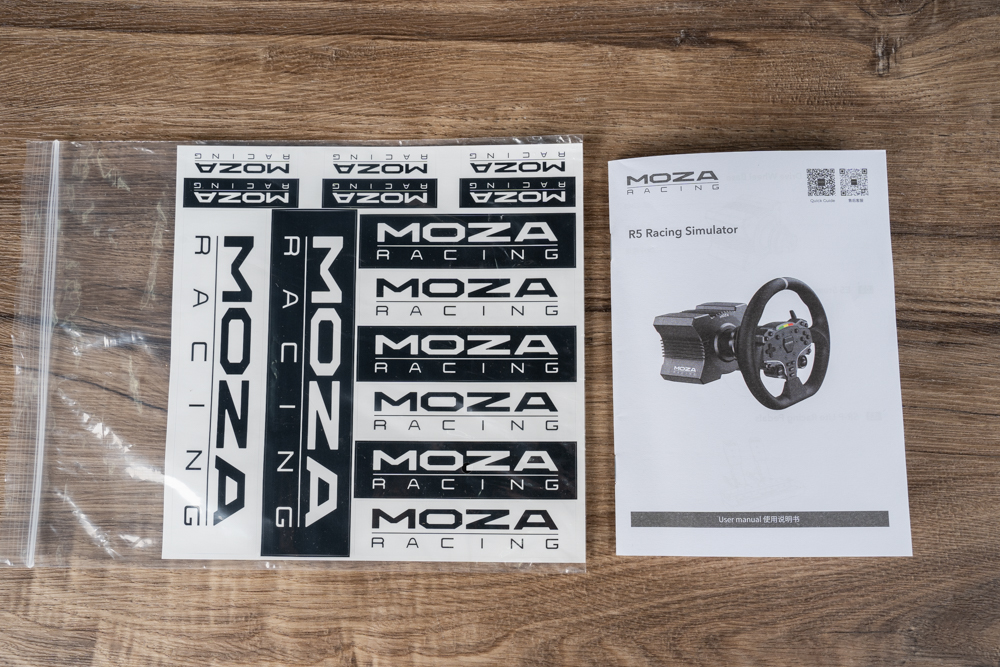
The image displays what appears to be the user manual for the MOZA R5 Racing Simulator, accompanied by a sheet of stickers bearing the MOZA RACING logo. The user manual is essential for guiding consumers through the setup process, usage, and maintenance of the simulator, while the stickers offer a personalization option for enthusiasts to display their brand allegiance on their equipment, workspace, or elsewhere. Including branded stickers is a nice touch that can enhance the sense of community and brand engagement among users.
Arozzi Velocita Racing Simulator Frame: The Ultimate Space-Saving Solution for Immersive Racing Experiences
The challenge of finding space for a racing simulator setup is indeed significant, especially in places like Taiwan where living areas can be limited. Arozzi, the Swedish brand known for its gaming peripherals, addresses this issue with its Velocita omnidirectional simulator racing frame. This innovative solution is designed to provide an ergonomic and authentic racing posture in the smallest possible footprint, with the added benefit of being foldable for storage when not in use.
Arozzi’s Velocita stands out because it is compatible with various chairs with a five-star base, including racing, gaming, and office chairs. This adaptability reduces the initial cost and space required for a full-fledged racing chair setup and provides versatility in choosing a comfortable seat. Furthermore, its compatibility with mainstream steering wheels, pedal sets, and shifters ensures that the Velocita can cater to a wide array of sim racing equipment, enhancing its appeal to a broad audience.
The omnidirectional adjustment feature is a key aspect of the Velocita, as it allows players to fine-tune their driving position with ease, ensuring that each user can achieve a comfortable and natural setup. This focus on customization and ergonomic design makes it a smart choice for newcomers apprehensive about the space and investment required for a dedicated sim racing setup.
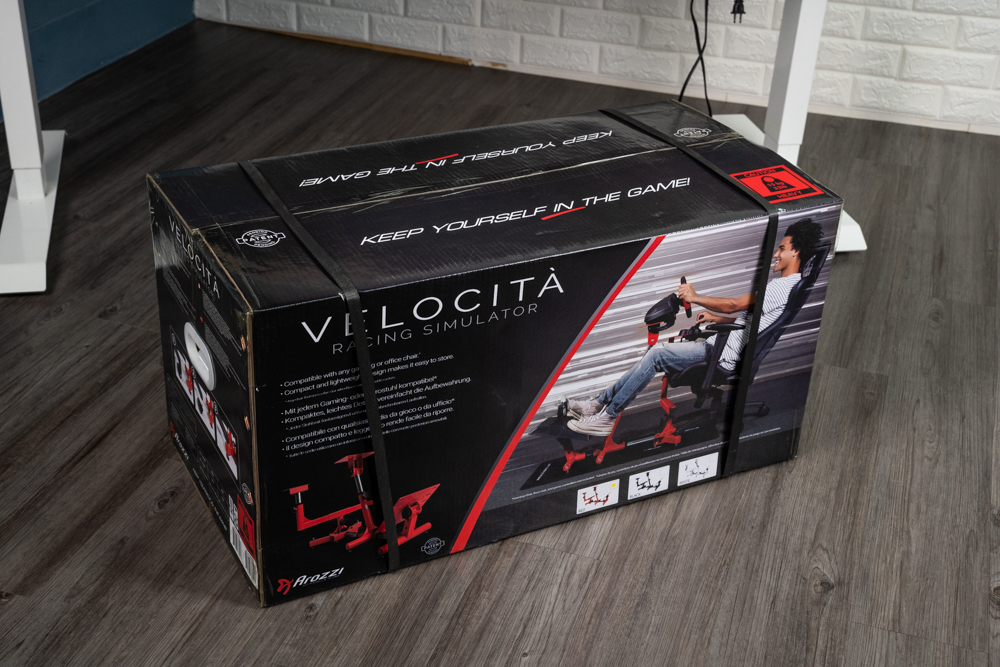
The packaging of the Arozzi Velocita racing simulator frame. It highlights the product’s sturdy metal construction with a substantial net weight of 19 kilograms, suggesting it’s built to provide a solid and stable racing experience. The packaging also emphasizes compatibility and versatility, likely appealing to those serious about their sim racing setup. The box art, featuring an image of a user enjoying the simulator frame, helps convey the immersive experience that the Velocita aims to provide.
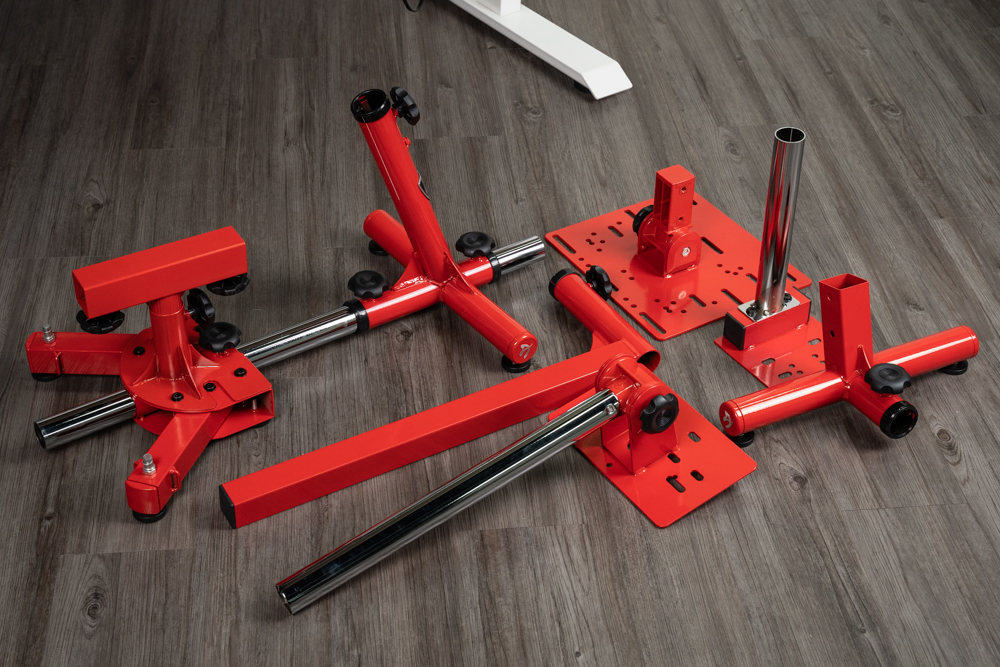
The disassembled components of the Arozzi Velocita racing simulator frame laid out, ready for assembly. The vibrant red color of the metal parts not only makes a bold visual statement but also indicates that the frame is designed to stand out in a gaming setup. The various rods, brackets, and base elements suggest a modular design, which typically allows for a straightforward and user-friendly assembly process. Despite the need for self-assembly, the simplicity of the design, as implied, would make the setup accessible even for those who may not be very experienced in constructing such equipment. The construction appears to prioritize both stability and ease of assembly, factors that are crucial for ensuring a seamless and enjoyable building experience for the user.
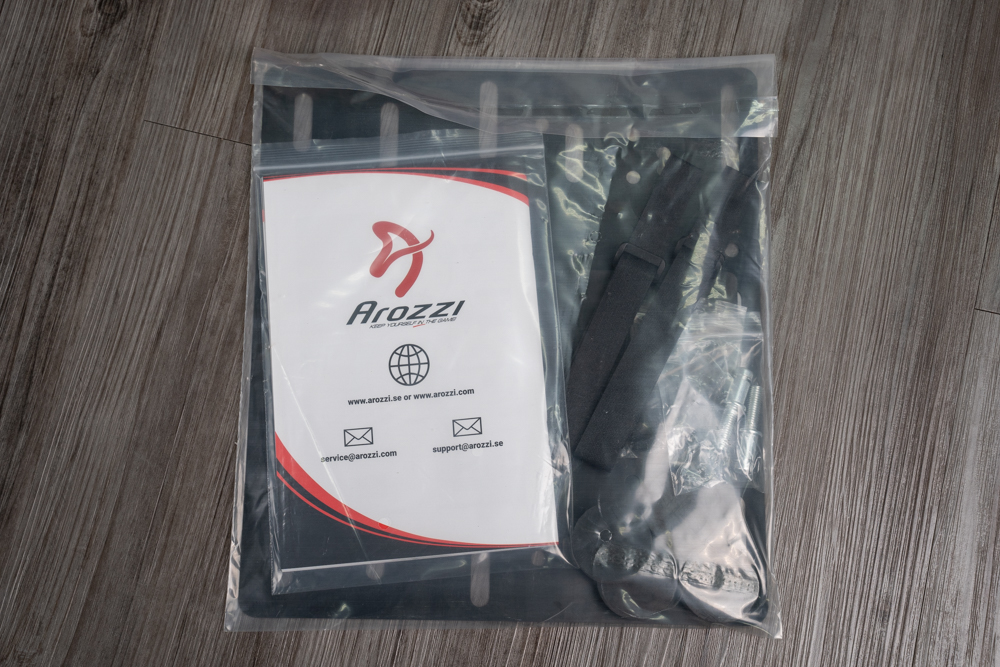
An accessory pack for the Arozzi Velocita racing simulator frame. Inside the plastic bag, along with the user manual, there appear to be silicone pads, which are likely used for the steering wheel, gear shifter, and pedal plates. These pads enhance grip and reduce slippage, ensuring the equipment stays firmly in place during use. They also help to protect the surfaces of both the simulator frame and the peripherals from scratches and wear. Including these accessories speaks to Arozzi’s focus on detail and user satisfaction, providing everything necessary for a complete, secure setup right out of the box.
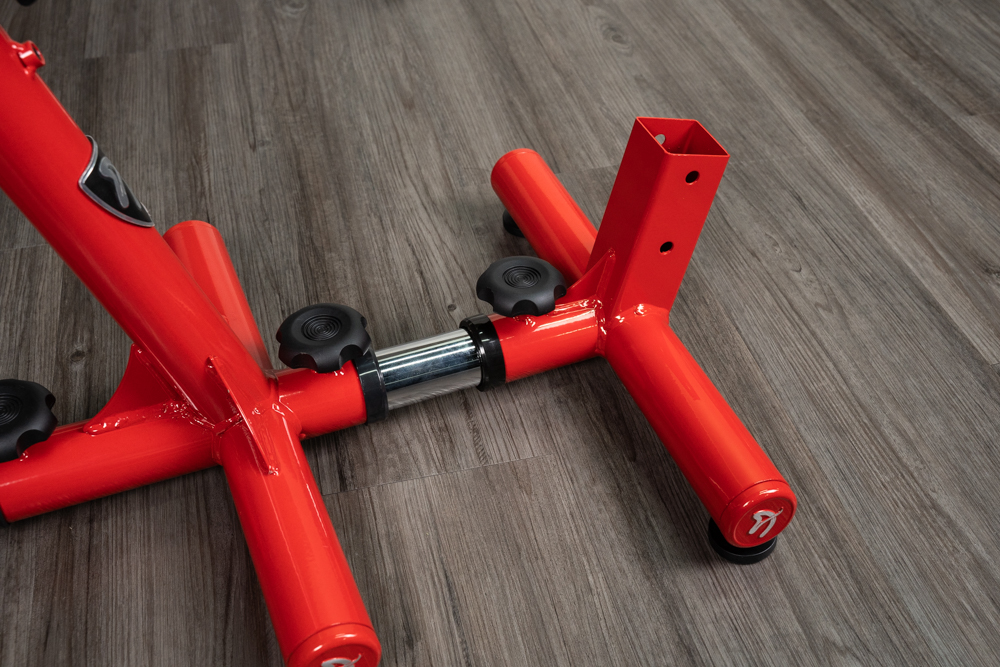
A detailed view of part of the Arozzi Velocita racing simulator frame, focusing on the assembly mechanism. It shows how the components fit together, with knobs that likely function to tighten and secure the joints once the parts are aligned. This simple yet effective system indicates that assembly is straightforward, requiring no specialized tools or equipment. Just by fitting the parts together and tightening the hand-operated knobs, users can quickly set up their simulator frame and adjust it to their liking, illustrating the user-friendly design Arozzi aims to provide. The ease of assembly makes it accessible for users of all skill levels to construct their racing simulator setup without additional help.
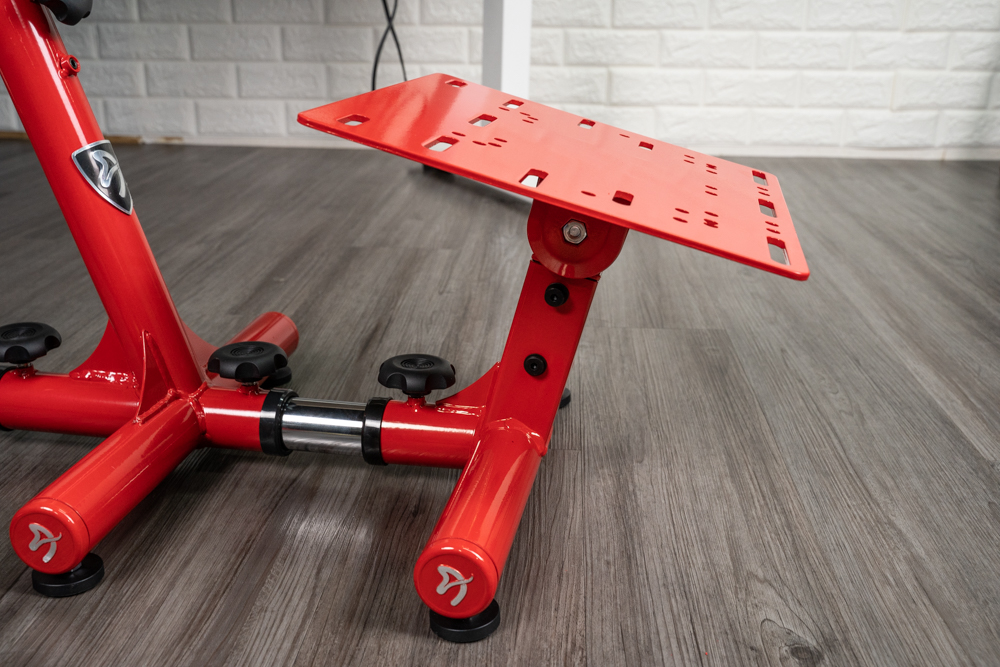
The pedal platform of the Arozzi Velocita racing simulator frame, which features a large range of angle adjustability. This adjustability allows users to find the most comfortable and ergonomic position for their driving style, which is essential for both comfort and control during long sim racing sessions. The platform’s design shows multiple holes and slots, indicating versatility for mounting different pedal sets and the ability to fine-tune their positioning. This level of customization is a valuable feature for sim racers who seek a personalized setup that can be tailored precisely to their preferences.
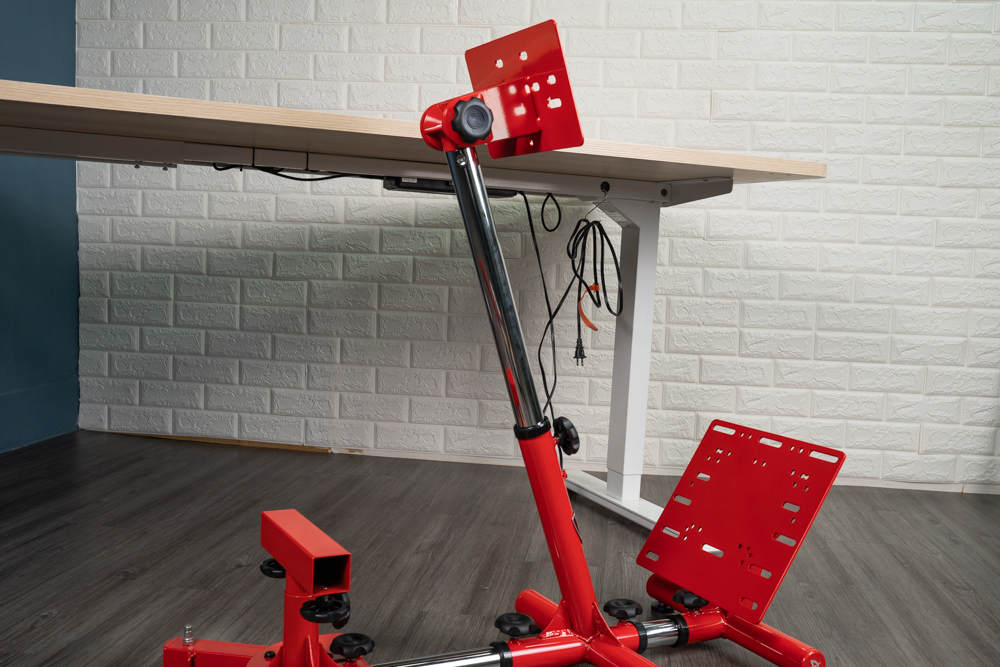
We see the Arozzi Velocita racing simulator’s steering wheel support structure, featuring adjustable height and tilt angle mechanisms. The flexibility in adjustment allows users to position the steering wheel at the optimal level and angle for their comfort and performance. This adaptability is key for an immersive and ergonomic racing experience, accommodating users of different sizes and preferred driving postures. The red frame with its adjustment knobs and levers is designed for ease of use, making it possible to fine-tune the simulator to individual preferences without needing tools. The design and functionality underscore the frame’s commitment to a customizable sim racing setup.
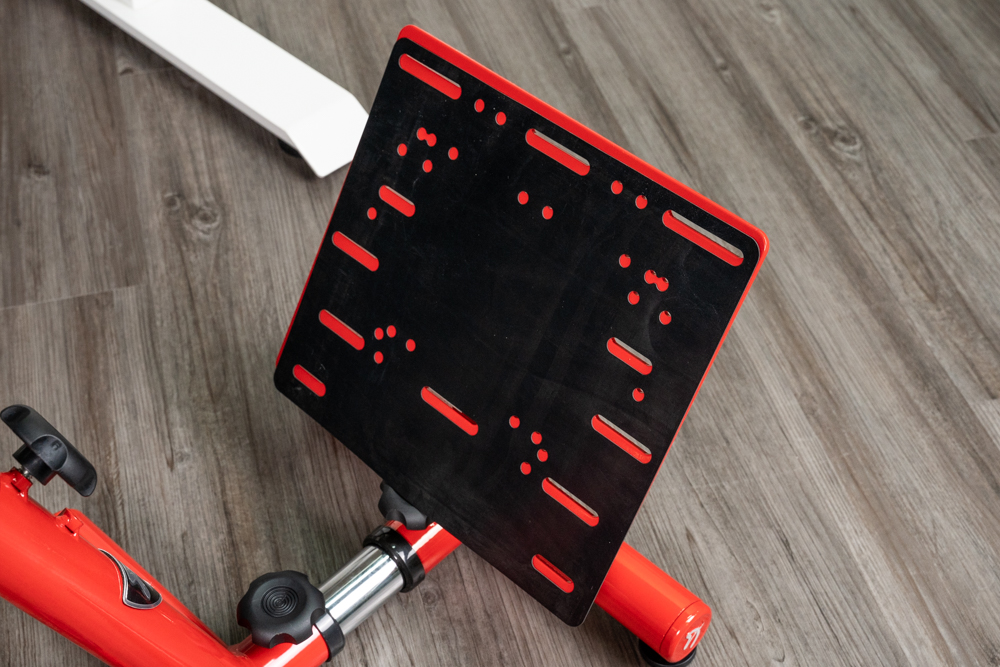
The pedal plate of the Arozzi Velocita racing simulator frame, and mentioned are the included silicone pads for the steering wheel, pedals, and shifter. These silicone pads are essential for creating a non-slip surface and providing cushioning to reduce wear and tear on both the peripherals and the frame. The thoughtful inclusion of these pads demonstrates Arozzi’s commitment to protecting the equipment and enhancing the user experience by preventing any direct metal-to-metal contact that could potentially cause damage over time.
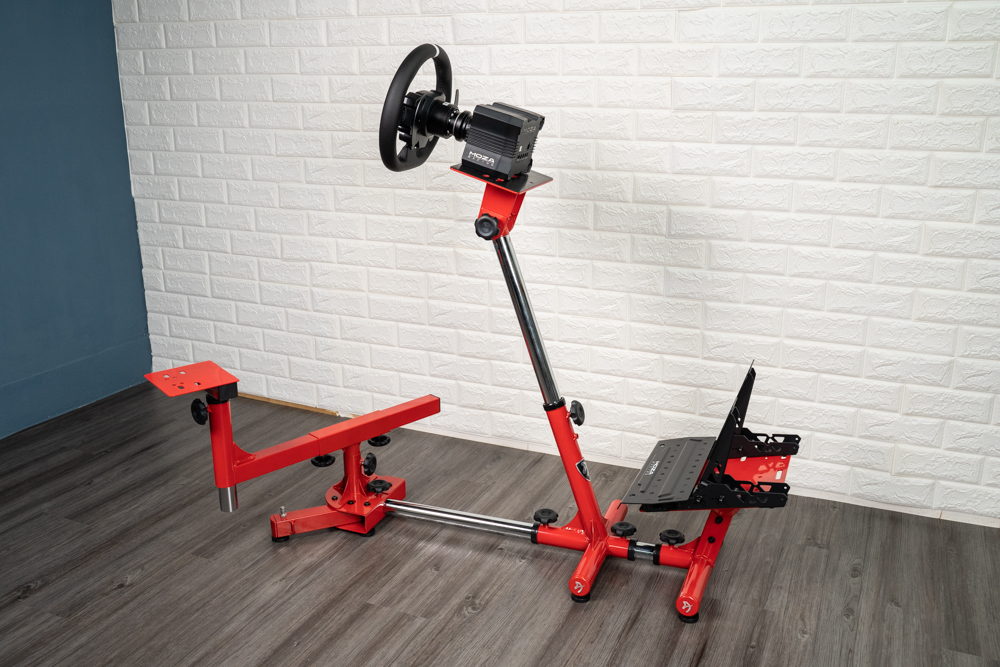
The fully assembled Arozzi Velocita racing simulator frame with the steering wheel and pedal set installed. The frame’s bright red finish is striking and adds an aesthetic appeal to the setup. The steering wheel is mounted on an adjustable bracket, and the pedal set is attached to the base plate, which shows the silicone pads in place to prevent slippage and protect the metal surfaces. The design looks to be ergonomic, offering a realistic driving position. The overall setup, with its clean lines and attention to detail, conveys a sense of a high-quality, functional, and visually appealing racing simulation environment.
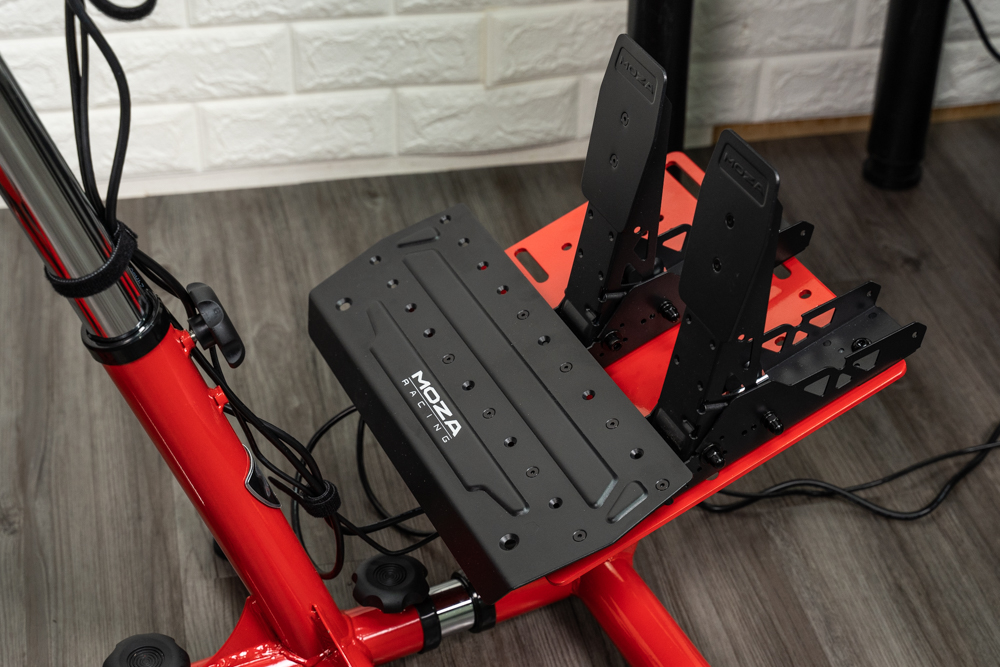
The bottom part of the MOZA SR-P Lite pedals includes rubber non-slip pads attached directly to the pedal base. These built-in pads ensure the pedals stay in place on smooth surfaces, providing stability during use. The presence of these pads indicates that there’s no immediate need for the additional silicone pads provided with the Arozzi Velocita racing frame for these pedals, though they could be used if desired for extra grip or protection. The setup shown here is tailored for users seeking a secure and stable pedal arrangement without the necessity of mounting them to a racing frame.
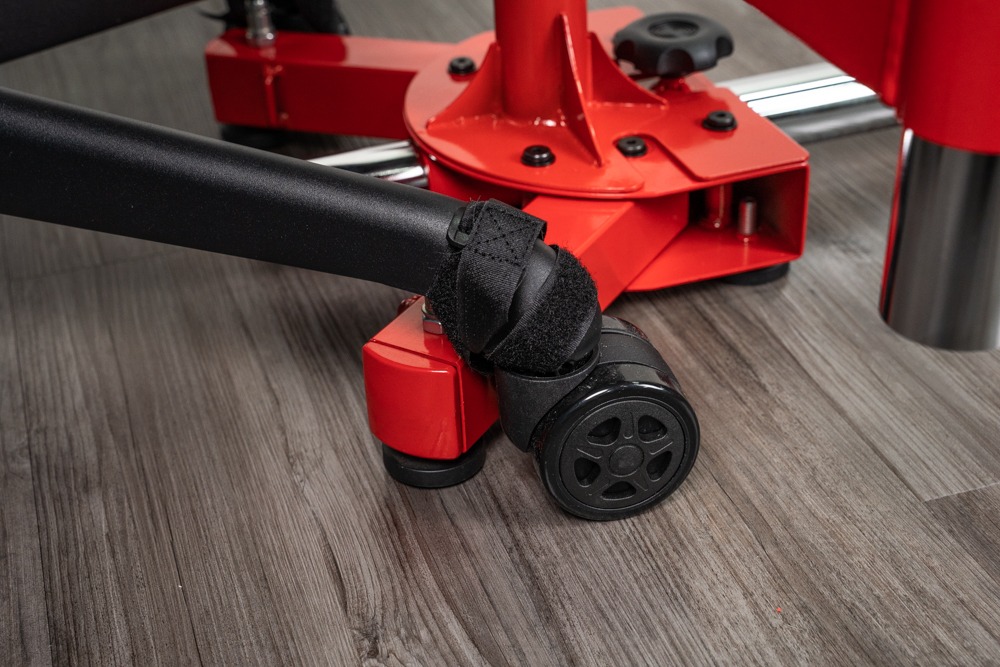
We see the use of straps as a method to secure a chair to the Arozzi Velocita racing simulator frame. This system allows for easy attachment of a chair with a five-star base, providing a quick and straightforward way to integrate most standard office or gaming chairs into the setup.
Arozzi Velocita offers this dual-option approach for versatility: either using the straps for temporary and flexible attachment or removing two wheels from the chair and affixing the chair directly to the frame using designated holes for a more permanent and stable solution. This adaptability makes it convenient for users to decide the best mounting option according to their preferences and the nature of their space. Both methods have been tested to ensure stability, which is essential for maintaining a consistent and immersive racing experience.
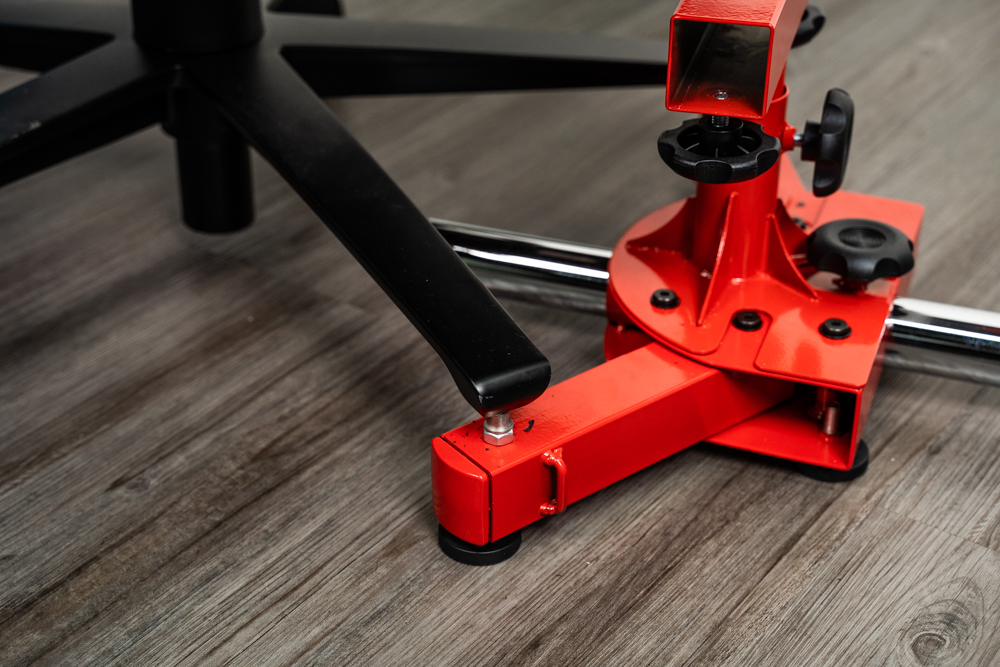
The alternative method of securing a chair to the Arozzi Velocita racing simulator frame is by removing the chair’s wheels and mounting it directly onto the frame’s base. The red bracket designed for this purpose provides a solid and stable attachment point, ensuring the chair remains stationary during intense gaming sessions. This setup is ideal for those who prefer a more permanent solution over the use of straps, offering enhanced stability and seamless integration with the racing frame design. The knobs and adjustable components on the frame allow for customization and fine-tuning of the setup for optimal comfort and ergonomics.
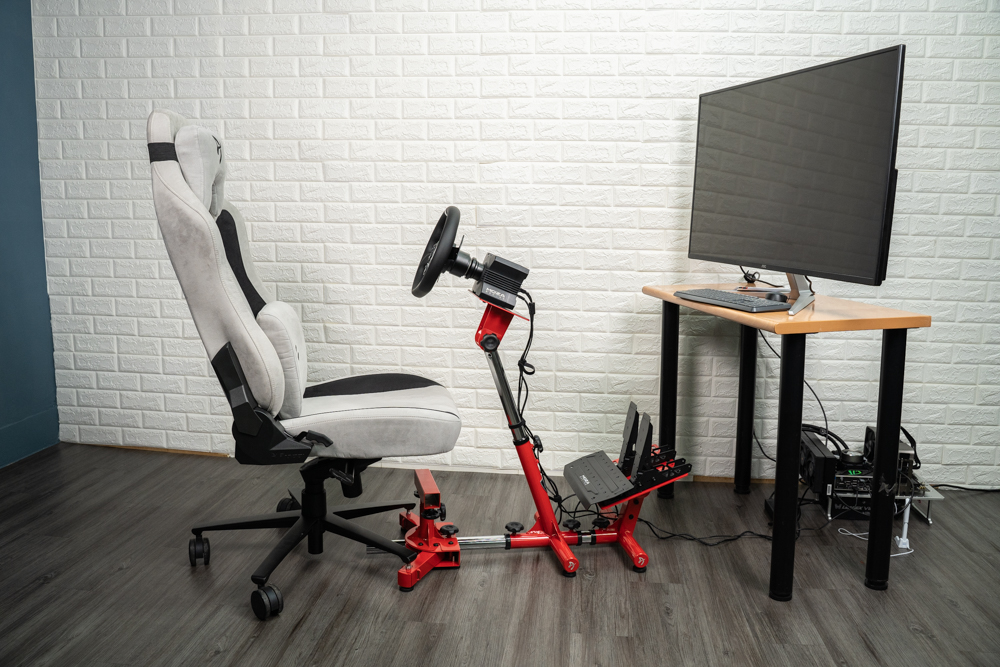
A complete sim racing setup featuring the Arozzi Velocita racing simulator frame with a chair and peripherals installed, positioned next to a desk with a monitor on top. The setup appears to be ready for use, with all components properly aligned for a cohesive sim racing experience. It’s important to note, as suggested, that all joints and knobs should be tightened securely to prevent any loosening during gameplay, which could affect stability and performance. Ensuring that everything is fastened tightly will help maintain the simulator’s structural integrity and provide a consistent and immersive racing environment.
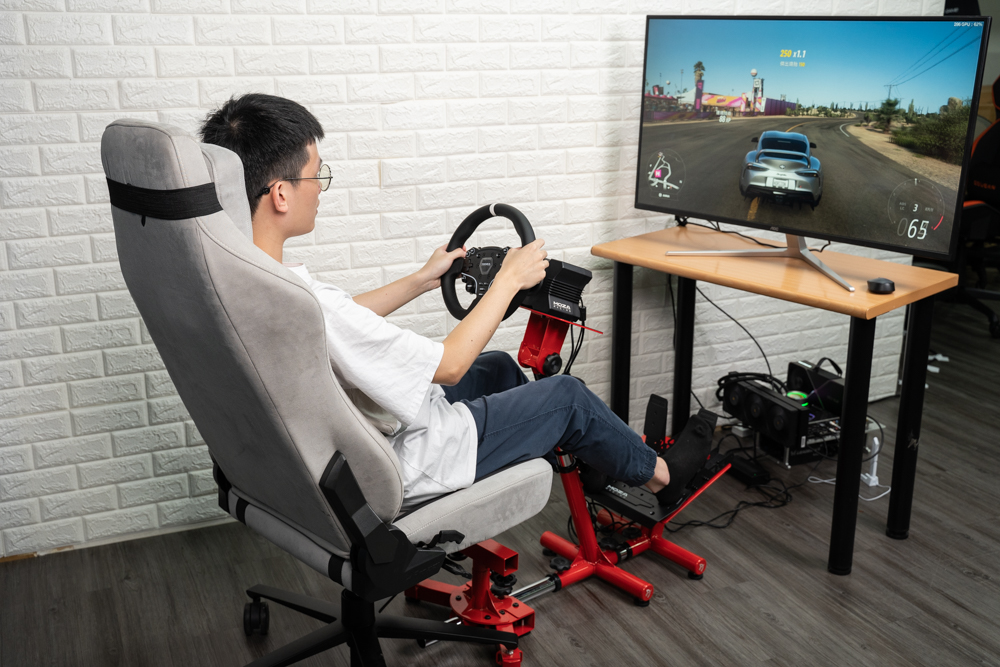
An individual using the complete sim racing setup. They are comfortably seated in a chair attached to the Arozzi Velocita racing simulator frame and actively engaged with a racing game displayed on the monitor in front of them. The positioning of the steering wheel and pedals appears to be well-adjusted to match the player’s posture and reach, illustrating the ergonomics of the setup. The simulator frame and peripherals are neatly integrated, offering a compact and efficient racing environment suitable for home use. It’s a practical example of how sim racing enthusiasts can enjoy a realistic driving experience in their own space.
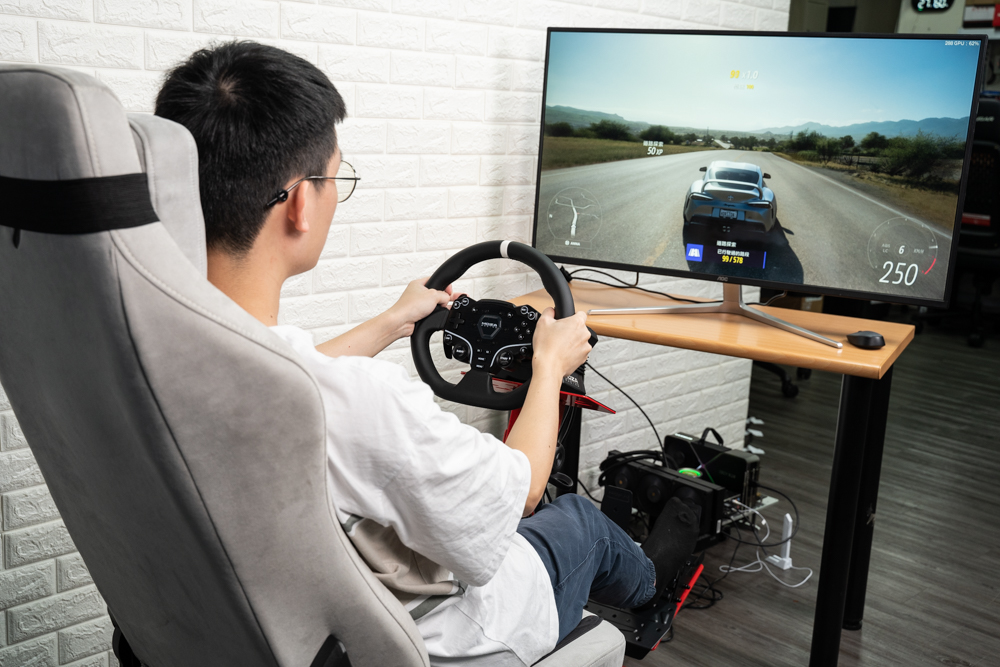
Here we have the sim racing setup in action, hands on the MOZA ES steering wheel, which is part of the Arozzi Velocita racing simulator frame. The player is focused on the screen, where a high-speed racing game is in progress, demonstrating the immersive potential of the setup. The steering wheel’s position and the visible MOZA branding showcase the wheel’s compatibility with the frame and the seamless integration of the components for a realistic driving experience. The player’s posture and the proximity to the monitor suggest a comfortable and engaging environment tailored for sim racing.
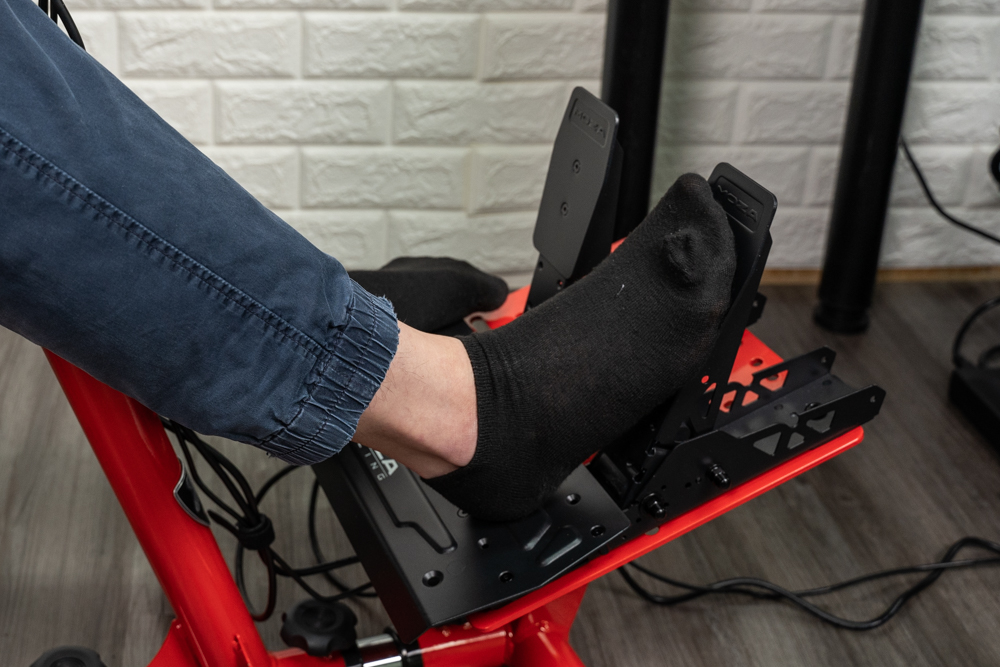
The photo zooms in on a user’s feet interacting with the MOZA SR-P Lite dual pedal set. It’s a moment that highlights the real-world use of the pedals, likely showing the pressure being applied during gameplay. The pedals’ design and the user’s relaxed foot placement suggest the equipment is engineered for comfort and responsiveness, key for a realistic driving simulation experience. The setup looks clean, professional, and ready to deliver a satisfying feedback to the racer’s inputs.
Optimize Your Racing Experience with MOZA Pit House: Tailored Settings and Firmware Updates for Every Racer
MOZA Pit House is a dedicated software suite designed specifically for MOZA racing simulators, providing a detailed array of adjustable settings to fine-tune the simulator’s hardware for an optimal racing experience. This software plays a crucial role in ensuring that both novice and experienced sim racers can customize their equipment to their liking.
For newcomers who might find the array of options daunting, MOZA Pit House offers a one-click setup feature. This convenience helps to streamline the process, automatically configuring key mappings for popular racing games and optimizing force feedback settings to match each game’s unique characteristics.
The software also includes preset configurations tailored to different driving styles, allowing users to select a setup that matches their personal approach to racing, whether they prefer a more aggressive and responsive setup or a smoother, more stable feedback profile.
The ability to update the firmware via MOZA Pit House ensures that users can always access the latest features and improvements, keeping their racing simulator up-to-date and enhancing the overall user experience. This commitment to software support is an important aspect of the product ecosystem, as it allows the hardware to evolve and improve over time.
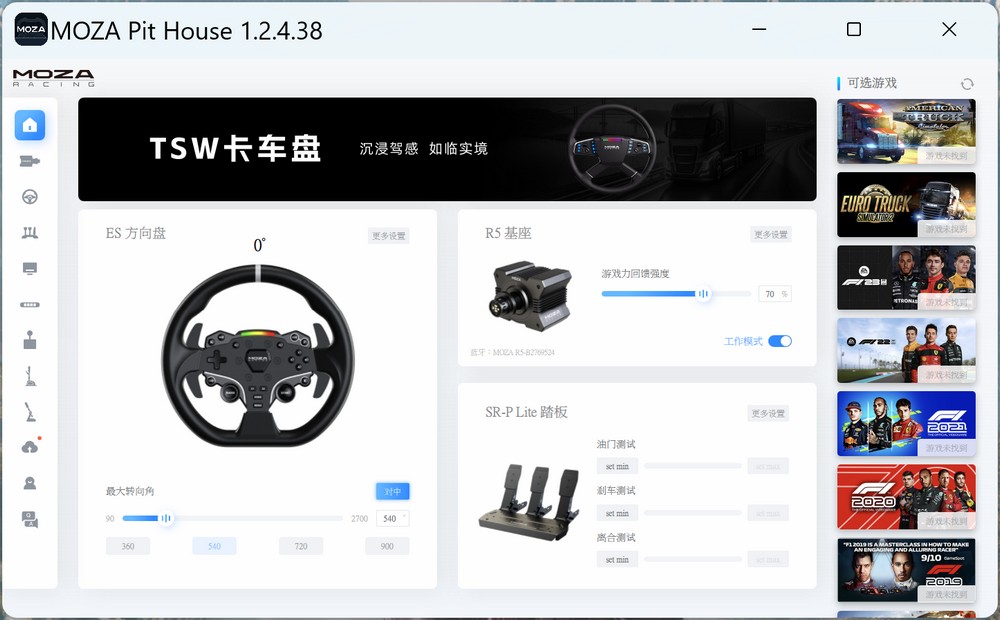
The interface of the MOZA Pit House software, version 1.2.4.38. It presents the basic settings on the homepage where users can adjust and configure their MOZA racing simulator peripherals, such as the ES steering wheel, R5 base, and SR-P Lite pedals.
In the steering wheel section, there is a rotation angle setting, allowing the user to define the range of motion for the wheel. Below that, the R5 base shows an option for force feedback intensity, which can be fine-tuned using a slider for a more or less intense driving experience.
For the pedals, minimum values can be set for each pedal, presumably to adjust the starting point of pedal responsiveness. This can be particularly useful for ensuring that the pedals only register input beyond a certain pressure threshold.
The software features a carousel of game profiles to the right, suggesting that users can select pre-configured settings optimized for specific racing titles. This is convenient for gamers who play various racing games and seek optimal performance for each one.
The clean and intuitive layout of the MOZA Pit House software demonstrates a focus on a user-friendly experience, offering easy access to essential settings that enhance the sim racing experience.
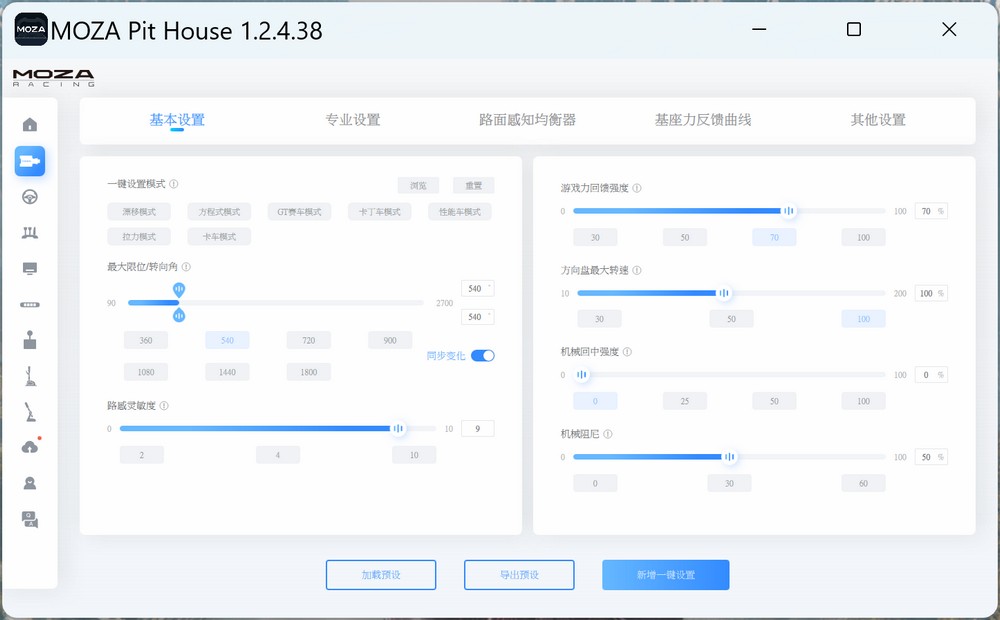
The basic settings in the MOZA Pit House software. It provides sliders and options to customize various aspects of the racing simulator hardware to suit the user’s preferences. The interface includes sliders for adjusting the steering wheel’s maximum rotation angle and force feedback settings like intensity and damping, as well as various filters to refine the feedback from the simulator to make it more or less aggressive.
On the right side, there are more specific settings for fine-tuning the driving experience. These might include adjustments for understeer or oversteer tendencies, road textures, and other feedback nuances that contribute to the realism of the simulation.
Each slider has a numerical range, allowing users to make precise adjustments. The clean and organized layout ensures that even those with limited technical knowledge can make these changes without feeling overwhelmed.
This level of customization helps users create a driving experience that’s tailored not just to their personal preferences but also to the particularities of different racing games and simulator software, enhancing their overall engagement with the simulation.
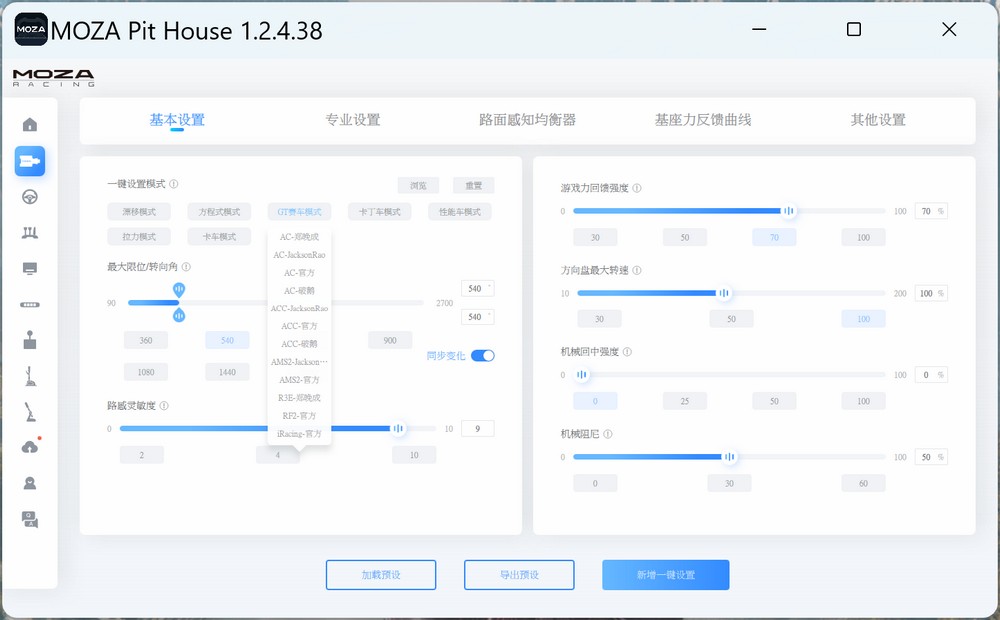
From the MOZA Pit House software, we can see that by right-clicking, users have access to a one-click setup feature, which brings up recommended parameters for a variety of games. This feature is particularly useful for those who want to quickly configure their simulator hardware with settings that are tailored to specific games, ensuring that the force feedback and overall responsiveness are as close as possible to what the game developers intended.
These presets likely include optimized values for steering wheel rotation, force feedback strength, and other nuanced adjustments, offering a convenient starting point for both novice and experienced users. By providing game-specific profiles, MOZA Pit House greatly simplifies the setup process and allows users to dive into their racing experience with confidence that their equipment is finely tuned for the best possible performance.
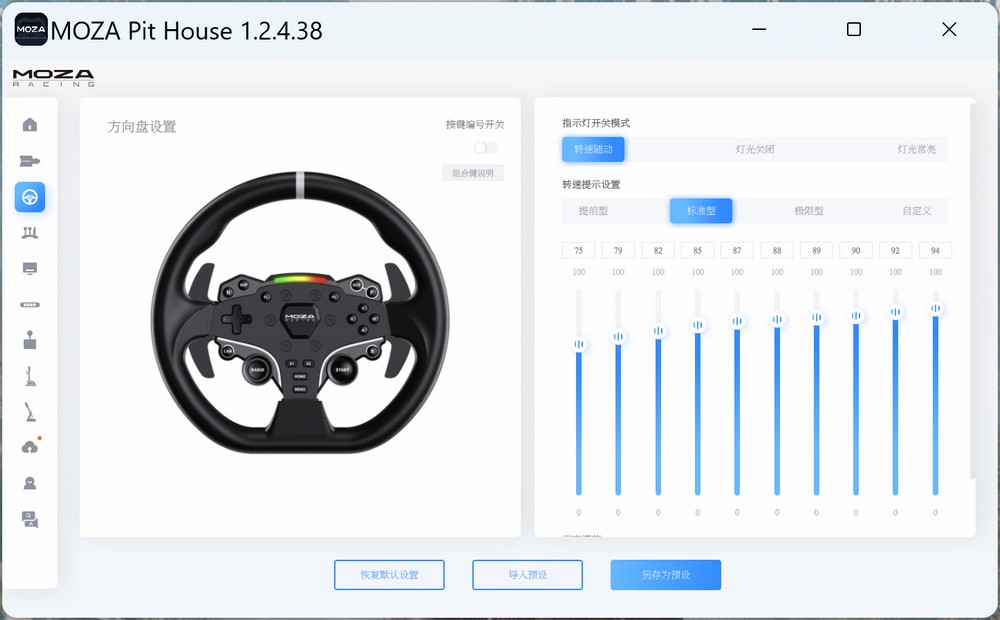
The steering wheel configuration section within the MOZA Pit House software. It offers a graphical representation of button assignments on the steering wheel, illustrating which actions are bound to each button. This level of customization ensures that players can tailor their control layouts precisely to their preferences or to better align with the in-game controls.
The array of numerical values likely corresponds to the function or action mapped to each button, with the ability to adjust and set each one according to individual needs. This could include gear shifting, DRS activation, menu navigation, or other in-game functions that are essential to racing gameplay.
This interface provides an easy-to-navigate method for users to customize their racing wheel and optimize their interaction with the game, thereby enhancing their overall gaming experience. It shows the thoroughness of MOZA in providing a user-friendly environment for personalizing simulation hardware.
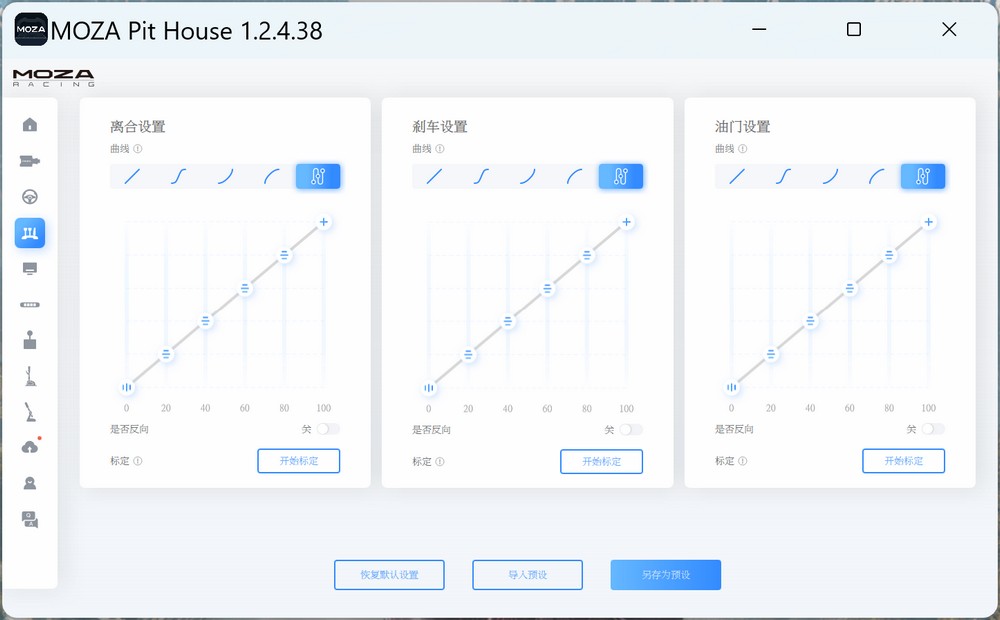
We see the pedal curve configuration options in the MOZA Pit House software. There are three different graphs displayed, each likely representing a different pedal: throttle, brake, and clutch. Users can adjust the response curves for each pedal, which changes how the pedal’s physical position translates to the input signal in the game.
By manipulating these curves, drivers can fine-tune how sensitive the pedals are at different range points. For instance, a steeper curve on the brake could make it more sensitive at the initial press, providing more braking power with less physical depression of the pedal. This is a valuable feature for sim racers who need precise control over their braking and acceleration, especially in games where such nuances can significantly affect driving performance.
The software seems to allow for both preset options and manual curve adjustments, ensuring that both novice users and experienced sim racers can achieve their desired pedal feel. The ability to easily adjust these settings is a testament to the software’s flexibility and the depth of customization available to users.
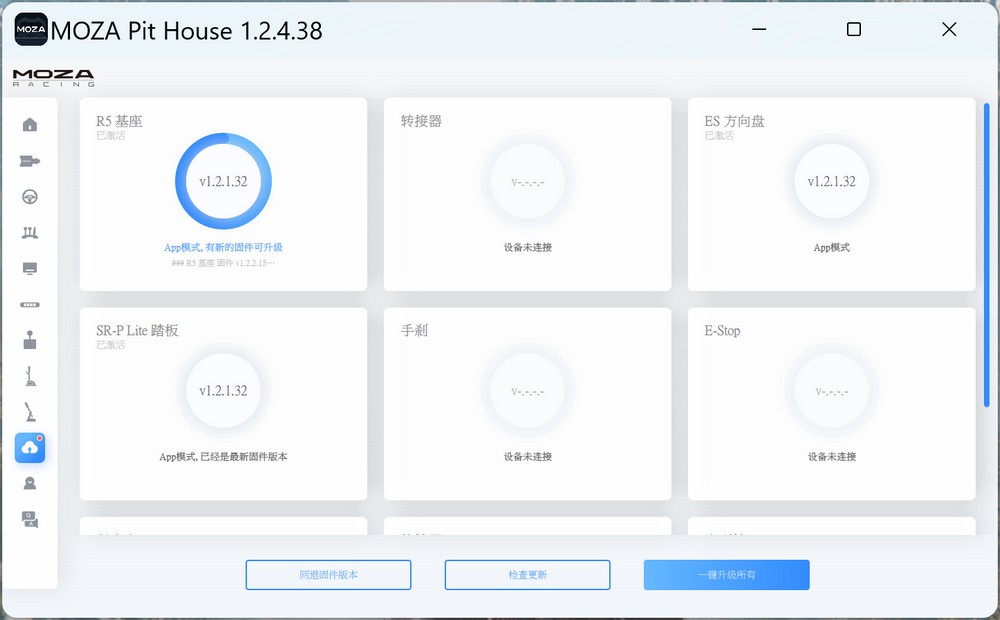
The MOZA Pit House software displays the firmware update section, where users can see the current firmware version for their racing simulator components such as the R5 base, SR-P Lite Pedals, and the ES steering wheel. There is a progress circle indicating the version number, which suggests an easy-to-follow process for keeping the devices up-to-date.
The screen also features an update button, likely to initiate the download and installation of new firmware. This functionality is crucial for maintaining device performance and compatibility and unlocking new features and improvements that come with software updates. Regular firmware updates can also address bugs and enhance the overall stability of the system, ensuring a smooth and immersive racing simulation experience.
Summarize
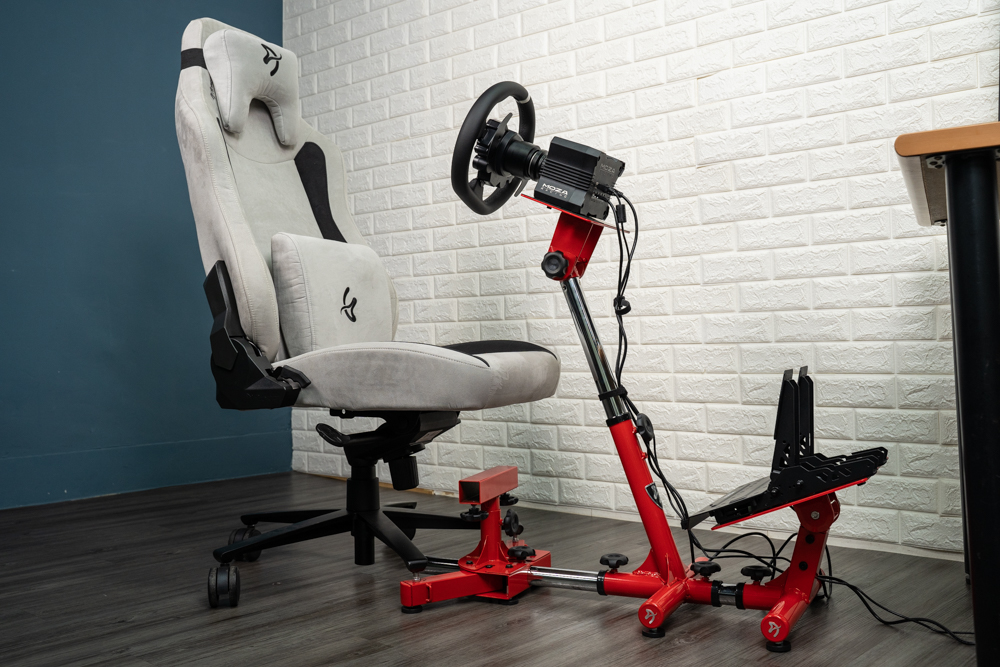
The MOZA RACING R5 racing simulator kit, though entry-level, has already captured the interest of everyone in the office. Distinct from belt gear steering wheels, the direct drive motor eliminates any “toy-like” feeling and replaces it with an immersive experience. Feeling the tire’s grip and refining every turn can make one forget their troubles, as they concentrate fully on wrestling with the wheel—a unity of driver and car that’s hard to put into words and only understood by those who share a passion for driving.
A strong point of MOZA’s offerings is its software ecosystem. The MOZA Pit House provides a plethora of adjustable options. Beginners can start with one-touch settings to practice and then gradually adjust according to their habits, avoiding the steep learning curve associated with complex parameters. Perhaps after a tiring day on the racetrack, switching to drift mode can offer a completely different driving joy.
The Arozzi Velocita’s patented design integrates with gaming chairs, effectively lowering the barrier to entry for a racing rig while offering a wealth of adjustability. Whether lying back in an F1 racer or sitting up like a European truck driver, it allows for a comfortable posture. The full-metal frame with automotive paint doesn’t look cheap, and its compatibility with mainstream brands allows for versatile play and easy storage. This setup isn’t just an indulgence in luxury—it’s an invitation to the immersive world of racing simulation.
If this article is helpful for you, please share this article with your friends on social media. Thank you!
This article is based on the personality of the reviews. You are responsible for fact-checking if the contents are not facts or accurate.
Title: Unlock Realistic Racing on a Budget: MOZA RACING R5 Simulator Kit Review